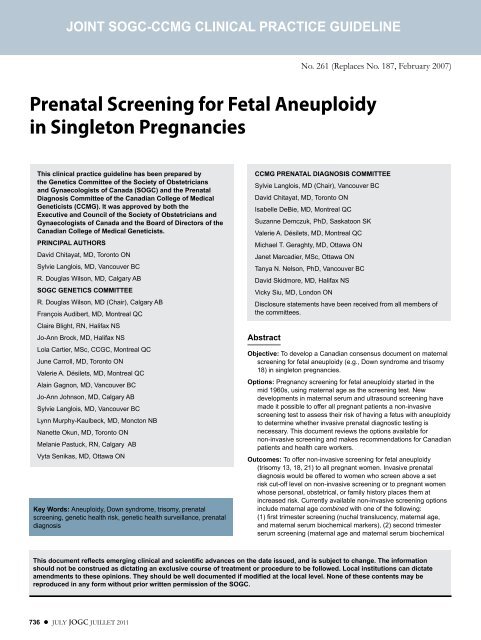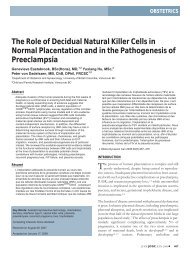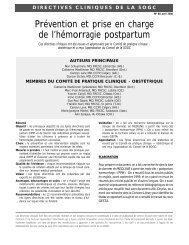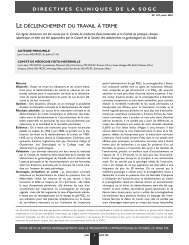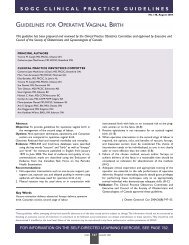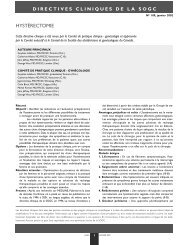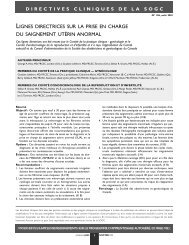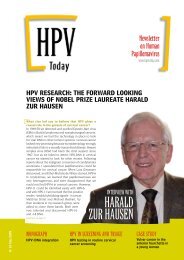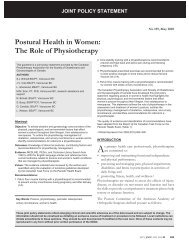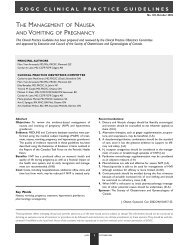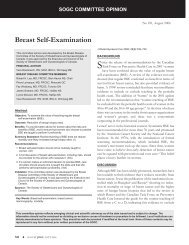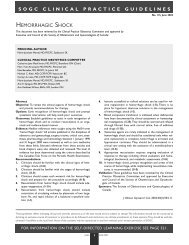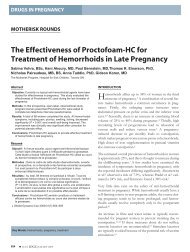Prenatal Screening for Fetal Aneuploidy in Singleton ... - SOGC
Prenatal Screening for Fetal Aneuploidy in Singleton ... - SOGC
Prenatal Screening for Fetal Aneuploidy in Singleton ... - SOGC
Create successful ePaper yourself
Turn your PDF publications into a flip-book with our unique Google optimized e-Paper software.
JOINT <strong>SOGC</strong>-CCMG CLINICAL PRACTICE GuIDELINE<br />
<strong>Prenatal</strong> <strong>Screen<strong>in</strong>g</strong> <strong>for</strong> <strong>Fetal</strong> <strong>Aneuploidy</strong><br />
<strong>in</strong> S<strong>in</strong>gleton Pregnancies<br />
This cl<strong>in</strong>ical practice guidel<strong>in</strong>e has been prepared by<br />
the Genetics Committee of the Society of Obstetricians<br />
and Gynaecologists of Canada (<strong>SOGC</strong>) and the <strong>Prenatal</strong><br />
Diagnosis Committee of the Canadian College of Medical<br />
Geneticists (CCMG). It was approved by both the<br />
Executive and Council of the Society of Obstetricians and<br />
Gynaecologists of Canada and the Board of Directors of the<br />
Canadian College of Medical Geneticists.<br />
PRINCIPAL AuTHORS<br />
David Chitayat, MD, Toronto ON<br />
Sylvie Langlois, MD, Vancouver BC<br />
R . Douglas Wilson, MD, Calgary AB<br />
<strong>SOGC</strong> GENETICS COMMITTEE<br />
R . Douglas Wilson, MD (Chair), Calgary AB<br />
François Audibert, MD, Montreal QC<br />
Claire Blight, RN, Halifax NS<br />
Jo-Ann Brock, MD, Halifax NS<br />
Lola Cartier, MSc, CCGC, Montreal QC<br />
June Carroll, MD, Toronto ON<br />
Valerie A . Désilets, MD, Montreal QC<br />
Ala<strong>in</strong> Gagnon, MD, Vancouver BC<br />
Jo-Ann Johnson, MD, Calgary AB<br />
Sylvie Langlois, MD, Vancouver BC<br />
Lynn Murphy-Kaulbeck, MD, Moncton NB<br />
Nanette Okun, MD, Toronto ON<br />
Melanie Pastuck, RN, Calgary AB<br />
Vyta Senikas, MD, Ottawa ON<br />
Key Words: <strong>Aneuploidy</strong>, Down syndrome, trisomy, prenatal<br />
screen<strong>in</strong>g, genetic health risk, genetic health surveillance, prenatal<br />
diagnosis<br />
736 l JULY JOGC JUILLET 2011<br />
Abstract<br />
No. 261 (Replaces No. 187, February 2007)<br />
CCMG PRENATAL DIAGNOSIS COMMITTEE<br />
Sylvie Langlois, MD (Chair), Vancouver BC<br />
David Chitayat, MD, Toronto ON<br />
Isabelle DeBie, MD, Montreal QC<br />
Suzanne Demczuk, PhD, Saskatoon SK<br />
Valerie A . Désilets, MD, Montreal QC<br />
Michael T . Geraghty, MD, Ottawa ON<br />
Janet Marcadier, MSc, Ottawa ON<br />
Tanya N . Nelson, PhD, Vancouver BC<br />
David Skidmore, MD, Halifax NS<br />
Vicky Siu, MD, London ON<br />
Disclosure statements have been received from all members of<br />
the committees .<br />
Objective: To develop a Canadian consensus document on maternal<br />
screen<strong>in</strong>g <strong>for</strong> fetal aneuploidy (e .g ., Down syndrome and trisomy<br />
18) <strong>in</strong> s<strong>in</strong>gleton pregnancies .<br />
Options: Pregnancy screen<strong>in</strong>g <strong>for</strong> fetal aneuploidy started <strong>in</strong> the<br />
mid 1960s, us<strong>in</strong>g maternal age as the screen<strong>in</strong>g test . New<br />
developments <strong>in</strong> maternal serum and ultrasound screen<strong>in</strong>g have<br />
made it possible to offer all pregnant patients a non-<strong>in</strong>vasive<br />
screen<strong>in</strong>g test to assess their risk of hav<strong>in</strong>g a fetus with aneuploidy<br />
to determ<strong>in</strong>e whether <strong>in</strong>vasive prenatal diagnostic test<strong>in</strong>g is<br />
necessary . This document reviews the options available <strong>for</strong><br />
non-<strong>in</strong>vasive screen<strong>in</strong>g and makes recommendations <strong>for</strong> Canadian<br />
patients and health care workers .<br />
Outcomes: To offer non-<strong>in</strong>vasive screen<strong>in</strong>g <strong>for</strong> fetal aneuploidy<br />
(trisomy 13, 18, 21) to all pregnant women . Invasive prenatal<br />
diagnosis would be offered to women who screen above a set<br />
risk cut-off level on non-<strong>in</strong>vasive screen<strong>in</strong>g or to pregnant women<br />
whose personal, obstetrical, or family history places them at<br />
<strong>in</strong>creased risk . Currently available non-<strong>in</strong>vasive screen<strong>in</strong>g options<br />
<strong>in</strong>clude maternal age comb<strong>in</strong>ed with one of the follow<strong>in</strong>g:<br />
(1) first trimester screen<strong>in</strong>g (nuchal translucency, maternal age,<br />
and maternal serum biochemical markers), (2) second trimester<br />
serum screen<strong>in</strong>g (maternal age and maternal serum biochemical<br />
This document reflects emerg<strong>in</strong>g cl<strong>in</strong>ical and scientific advances on the date issued, and is subject to change. The <strong>in</strong><strong>for</strong>mation<br />
should not be construed as dictat<strong>in</strong>g an exclusive course of treatment or procedure to be followed. Local <strong>in</strong>stitutions can dictate<br />
amendments to these op<strong>in</strong>ions. They should be well documented if modified at the local level. None of these contents may be<br />
reproduced <strong>in</strong> any <strong>for</strong>m without prior written permission of the <strong>SOGC</strong>.
markers), or (3) 2-step <strong>in</strong>tegrated screen<strong>in</strong>g, which <strong>in</strong>cludes first<br />
and second trimester serum screen<strong>in</strong>g with or without nuchal<br />
translucency (<strong>in</strong>tegrated prenatal screen, serum <strong>in</strong>tegrated<br />
prenatal screen<strong>in</strong>g, cont<strong>in</strong>gent, and sequential) . These options are<br />
reviewed, and recommendations are made .<br />
Evidence: Studies published between 1982 and 2009 were retrieved<br />
through searches of PubMed or Medl<strong>in</strong>e and CINAHL and the<br />
Cochrane Library, us<strong>in</strong>g appropriate controlled vocabulary and key<br />
words (aneuploidy, Down syndrome, trisomy, prenatal screen<strong>in</strong>g,<br />
genetic health risk, genetic health surveillance, prenatal diagnosis) .<br />
Results were restricted to systematic reviews, randomized controlled<br />
trials, and relevant observational studies . There were no language<br />
restrictions . Searches were updated on a regular basis and<br />
<strong>in</strong>corporated <strong>in</strong> the guidel<strong>in</strong>e to August 2010 . Grey (unpublished)<br />
literature was identified through search<strong>in</strong>g the websites of health<br />
technology assessment and health technology assessmentrelated<br />
agencies, cl<strong>in</strong>ical practice guidel<strong>in</strong>e collections, cl<strong>in</strong>ical trial<br />
registries, and national and <strong>in</strong>ternational medical specialty societies .<br />
The previous Society of Obstetricians and Gynaecologists of<br />
Canada guidel<strong>in</strong>es regard<strong>in</strong>g prenatal screen<strong>in</strong>g were also reviewed<br />
<strong>in</strong> develop<strong>in</strong>g this cl<strong>in</strong>ical practice guidel<strong>in</strong>e .<br />
Values: The quality of evidence was rated us<strong>in</strong>g the criteria described<br />
<strong>in</strong> the Report of the Canadian Task Force on Preventive Health<br />
Care .<br />
Benefits, harms, and costs: This guidel<strong>in</strong>e is <strong>in</strong>tended to reduce<br />
the number of prenatal <strong>in</strong>vasive procedures done when maternal<br />
age is the only <strong>in</strong>dication . This will have the benefit of reduc<strong>in</strong>g the<br />
numbers of normal pregnancies lost because of complications of<br />
<strong>in</strong>vasive procedures . Any screen<strong>in</strong>g test has an <strong>in</strong>herent falsepositive<br />
rate, which may result <strong>in</strong> undue anxiety . It is not possible<br />
at this time to undertake a detailed cost-benefit analysis of the<br />
implementation of this guidel<strong>in</strong>e, s<strong>in</strong>ce this would require health<br />
surveillance and research and health resources not presently<br />
available; however, these factors need to be evaluated <strong>in</strong> a<br />
prospective approach by prov<strong>in</strong>cial and territorial <strong>in</strong>itiatives .<br />
Recommendations<br />
01 . All pregnant women <strong>in</strong> Canada, regardless of age, should be<br />
offered, through an <strong>in</strong><strong>for</strong>med counsell<strong>in</strong>g process, the option of a<br />
prenatal screen<strong>in</strong>g test <strong>for</strong> the most common cl<strong>in</strong>ically significant fetal<br />
ABBREVIATIONS<br />
AFP alpha fetoprote<strong>in</strong><br />
CVS chorionic villus sampl<strong>in</strong>g<br />
DR detection rate<br />
FPR false-positive rate<br />
FTS first trimester screen<strong>in</strong>g<br />
hCG human chorionic gonadotrop<strong>in</strong><br />
IPS <strong>in</strong>tegrated prenatal screen<strong>in</strong>g<br />
MMS multiple marker screen<strong>in</strong>g<br />
MoM multiples of the median<br />
MSAFP maternal serum alpha fetoprote<strong>in</strong><br />
NT nuchal translucency<br />
ONTD open neural tube defect<br />
PAPP-A pregnancy-associated plasma prote<strong>in</strong>-A<br />
PR positive rate<br />
SLOS Smith-Lemli-Opitz Syndrome<br />
uE3 unconjugated estriol<br />
<strong>Prenatal</strong> <strong>Screen<strong>in</strong>g</strong> <strong>for</strong> <strong>Fetal</strong> <strong>Aneuploidy</strong> <strong>in</strong> S<strong>in</strong>gleton Pregnancies<br />
aneuploidies <strong>in</strong> addition to a second trimester ultrasound <strong>for</strong> dat<strong>in</strong>g,<br />
assessment of fetal anatomy, and detection of multiples . (I-A)<br />
02 . Counsell<strong>in</strong>g must be non-directive and must respect a woman’s<br />
right to accept or decl<strong>in</strong>e any or all of the test<strong>in</strong>g or options offered<br />
at any po<strong>in</strong>t <strong>in</strong> the process . (III-A)<br />
03 . Maternal age alone is a poor m<strong>in</strong>imum standard <strong>for</strong> prenatal<br />
screen<strong>in</strong>g <strong>for</strong> aneuploidy, and it should not be used a basis <strong>for</strong><br />
recommend<strong>in</strong>g <strong>in</strong>vasive test<strong>in</strong>g when non-<strong>in</strong>vasive prenatal<br />
screen<strong>in</strong>g <strong>for</strong> aneuploidy is available . (II-2A)<br />
04 . Invasive prenatal diagnosis <strong>for</strong> cytogenetic analysis should not<br />
be per<strong>for</strong>med without multiple marker screen<strong>in</strong>g results except <strong>for</strong><br />
women who are at <strong>in</strong>creased risk of fetal aneuploidy (a) because<br />
of ultrasound f<strong>in</strong>d<strong>in</strong>gs, (b) because the pregnancy was conceived<br />
by <strong>in</strong> vitro fertilization with <strong>in</strong>tracytoplasmic sperm <strong>in</strong>jection, or<br />
(c) because the woman or her partner has a history of a previous<br />
child or fetus with a chromosomal abnormality or is a carrier of a<br />
chromosome rearrangement that <strong>in</strong>creases the risk of hav<strong>in</strong>g a<br />
fetus with a chromosomal abnormality . (II-2E)<br />
05 . At m<strong>in</strong>imum, any prenatal screen offered to Canadian women<br />
who present <strong>for</strong> care <strong>in</strong> the first trimester should have a detection<br />
rate of 75% with no more than a 3% false-positive rate . The<br />
per<strong>for</strong>mance of the screen should be substantiated by annual<br />
audit . (III-B)<br />
06 . The m<strong>in</strong>imum standard <strong>for</strong> women present<strong>in</strong>g <strong>in</strong> the second<br />
trimester should be a screen that has a detection rate of 75% with<br />
no more than a 5% false-positive rate . The per<strong>for</strong>mance of the<br />
screen should be substantiated by annual audit . (III-B)<br />
07 . First trimester nuchal translucency should be <strong>in</strong>terpreted <strong>for</strong> risk<br />
assessment only when measured by sonographers or sonologists<br />
tra<strong>in</strong>ed and accredited <strong>for</strong> this service and when there is ongo<strong>in</strong>g<br />
quality assurance (II-2A), and it should not be offered as a screen<br />
without biochemical markers <strong>in</strong> s<strong>in</strong>gleton pregnancies . (I-E)<br />
08 . Evaluation of the fetal nasal bone <strong>in</strong> the first trimester should<br />
not be <strong>in</strong>corporated as a screen unless it is per<strong>for</strong>med by<br />
sonographers or sonologists tra<strong>in</strong>ed and accredited <strong>for</strong> this<br />
service and there is ongo<strong>in</strong>g quality assurance . (II-2E)<br />
09 . For women who undertake first trimester screen<strong>in</strong>g, second<br />
trimester serum alpha fetoprote<strong>in</strong> screen<strong>in</strong>g and/or ultrasound<br />
exam<strong>in</strong>ation is recommended to screen <strong>for</strong> open neural tube<br />
defects . (II-1A)<br />
10 . Timely referral and access is critical <strong>for</strong> women and should be<br />
facilitated to ensure women are able to undergo the type of<br />
screen<strong>in</strong>g test they have chosen as first trimester screen<strong>in</strong>g .<br />
The first steps of <strong>in</strong>tegrated screen<strong>in</strong>g (with or without nuchal<br />
translucency), cont<strong>in</strong>gent, or sequential screen<strong>in</strong>g are per<strong>for</strong>med<br />
<strong>in</strong> an early and relatively narrow time w<strong>in</strong>dow . (II-1A)<br />
11 . Ultrasound dat<strong>in</strong>g should be per<strong>for</strong>med if menstrual or conception<br />
dat<strong>in</strong>g is unreliable . For any abnormal serum screen calculated<br />
on the basis of menstrual dat<strong>in</strong>g, an ultrasound should be done to<br />
confirm gestational age . (II-1A)<br />
12 . The presence or absence of soft markers or anomalies <strong>in</strong> the<br />
18- to 20-week ultrasound can be used to modify the a priori risk<br />
of aneuploidy established by age or prior screen<strong>in</strong>g . (II-2B)<br />
13 . In<strong>for</strong>mation such as gestational dat<strong>in</strong>g, maternal weight, ethnicity,<br />
<strong>in</strong>sul<strong>in</strong>-dependent diabetes mellitus, and use of assisted<br />
reproduction technologies should be provided to the laboratory to<br />
improve accuracy of test<strong>in</strong>g . (II-2A)<br />
14 . Health care providers should be aware of the screen<strong>in</strong>g modalities<br />
available <strong>in</strong> their prov<strong>in</strong>ce or territory . (III-B)<br />
15 . A reliable system needs to be <strong>in</strong> place ensur<strong>in</strong>g timely report<strong>in</strong>g of<br />
results . (III-C)<br />
JULY JOGC JUILLET 2011 l 737
JOINT <strong>SOGC</strong>-CCMG CLINICAL PRACTICE GuIDELINE<br />
16 . <strong>Screen<strong>in</strong>g</strong> programs should be implemented with resources that<br />
support audited screen<strong>in</strong>g and diagnostic laboratory services,<br />
ultrasound, genetic counsell<strong>in</strong>g services, patient and health care<br />
provider education, and high quality diagnostic test<strong>in</strong>g, as well<br />
as resources <strong>for</strong> adm<strong>in</strong>istration, annual cl<strong>in</strong>ical audit, and data<br />
management . In addition, there must be the flexibility and fund<strong>in</strong>g<br />
to adjust the program to new technology and protocols . (II-3B)<br />
J Obstet Gynaecol Can 2011;33(7):736–750<br />
INTRODuCTION<br />
<strong>Screen<strong>in</strong>g</strong> <strong>for</strong> chromosomal anomalies and open<br />
neural tube defects is part of prenatal care offered<br />
to all Canadian women. S<strong>in</strong>ce the methods of screen<strong>in</strong>g<br />
<strong>for</strong> ONTDs have not changed s<strong>in</strong>ce the mid-1970s, they<br />
are not discussed here. <strong>Screen<strong>in</strong>g</strong> <strong>for</strong> ONTDs <strong>in</strong> Canada<br />
requires second trimester serum alpha fetoprote<strong>in</strong> (16 to 20<br />
completed weeks) and/or ultrasound exam<strong>in</strong>ation done at<br />
18 to 22 weeks of gestation.<br />
<strong>Screen<strong>in</strong>g</strong> <strong>for</strong> fetal chromosomal anomalies, <strong>in</strong>clud<strong>in</strong>g<br />
Down syndrome, began with amniocentesis <strong>in</strong> the mid-<br />
1960s. At that time, the criterion <strong>for</strong> screen<strong>in</strong>g was maternal<br />
age. In Canada, screen<strong>in</strong>g was offered only to women ≥ 35<br />
years at the expected date of delivery. This was determ<strong>in</strong>ed<br />
to be the po<strong>in</strong>t at which the risk of a pregnancy loss was less<br />
than the chance of identify<strong>in</strong>g a pregnancy with a significant<br />
chromosomal abnormality. This cl<strong>in</strong>ical practice guidel<strong>in</strong>e<br />
reviews the evolution of screen<strong>in</strong>g <strong>for</strong> fetal aneuploidy<br />
from screen<strong>in</strong>g us<strong>in</strong>g maternal age alone to the many<br />
options currently available and makes recommendations<br />
regard<strong>in</strong>g the m<strong>in</strong>imum standard of prenatal screen<strong>in</strong>g that<br />
should be available to all Canadian women. The level of<br />
evidence and quality of recommendations are described<br />
us<strong>in</strong>g the criteria and classifications of the Canadian Task<br />
Force on Preventive Health Care 1 (Table 1).<br />
WHAT IS SCREENING?<br />
<strong>Screen<strong>in</strong>g</strong> is the process of survey<strong>in</strong>g a population, us<strong>in</strong>g<br />
a specific marker or markers and def<strong>in</strong>ed screen<strong>in</strong>g cut-off<br />
levels, to identify the <strong>in</strong>dividuals <strong>in</strong> the population at higher<br />
risk <strong>for</strong> a particular disorder. <strong>Screen<strong>in</strong>g</strong> is applicable to a<br />
population; diagnosis is applied at the <strong>in</strong>dividual patient<br />
level. 2<br />
<strong>Screen<strong>in</strong>g</strong> <strong>for</strong> a disorder should be undertaken only when<br />
the disorder is considered to be serious enough to warrant<br />
<strong>in</strong>tervention. The marker or markers used <strong>in</strong> screen<strong>in</strong>g must<br />
be sufficiently sensitive to identify a significant proportion<br />
of affected persons with m<strong>in</strong>imal misidentification of<br />
unaffected persons. There must also be both a highly<br />
accurate diagnostic test to determ<strong>in</strong>e whether the person<br />
738 l JULY JOGC JUILLET 2011<br />
with a screen positive result truly has the disorder and an<br />
<strong>in</strong>tervention available to all persons who are identified as<br />
be<strong>in</strong>g affected. The screen, <strong>in</strong>clud<strong>in</strong>g follow-up test<strong>in</strong>g and<br />
<strong>in</strong>tervention, must be af<strong>for</strong>dable. F<strong>in</strong>ally the screen must be<br />
acceptable to the population be<strong>in</strong>g screened.<br />
The screen<strong>in</strong>g procedure should not be merely a test but<br />
must be a comprehensive program. The program must<br />
<strong>in</strong>clude the provision of understandable <strong>in</strong><strong>for</strong>mation <strong>for</strong><br />
both patients and health care providers to ensure <strong>in</strong><strong>for</strong>med<br />
decision-mak<strong>in</strong>g, timely access to the screen<strong>in</strong>g test, a<br />
system of notification of results and referral to follow-up<br />
test<strong>in</strong>g, and access to an <strong>in</strong>tervention. The screen<strong>in</strong>g process<br />
must allow patients to decl<strong>in</strong>e <strong>in</strong>tervention at each step<br />
throughout the process. A screen<strong>in</strong>g program must <strong>in</strong>clude<br />
regular cl<strong>in</strong>ical audit to evaluate local per<strong>for</strong>mance and<br />
should have the flexibility to <strong>in</strong>corporate new technology.<br />
The Appendix provides a glossary of terms commonly<br />
used <strong>in</strong> screen<strong>in</strong>g<br />
IMPORTANT CONCEPTS uNDERLYING<br />
PRENATAL GENETIC SCREENING<br />
Multiple marker screen<strong>in</strong>g uses a comb<strong>in</strong>ation of maternal<br />
age and 2 or more biochemical tests, with or without an<br />
ultrasound exam<strong>in</strong>ation, to produce a s<strong>in</strong>gle result <strong>for</strong> risk<br />
of Down syndrome, trisomy 18, and ONTDs, which is<br />
used to offer options <strong>for</strong> cl<strong>in</strong>ical management. A screen<br />
is positive when the risk of one or more of the screened<br />
disorders falls above a designated risk cut-off. Counsell<strong>in</strong>g<br />
and further test<strong>in</strong>g options are offered when a screen is<br />
positive. In the discussion of prenatal screen<strong>in</strong>g, the terms<br />
false-positive rate or positive rate, and detection rate are<br />
used (Appendix). As screen<strong>in</strong>g per<strong>for</strong>mance improves, the<br />
FPR decreases and/or the DR <strong>in</strong>creases. A risk cut-off<br />
might be chosen based upon the desired DR, FPR, or a<br />
comb<strong>in</strong>ation of both. A risk cut-off is expressed as the risk<br />
or likelihood of the condition be<strong>in</strong>g present <strong>in</strong> the fetus<br />
at term or at mid-trimester. The risk <strong>for</strong> the latter will be<br />
higher, because 23% of fetuses with Down syndrome are<br />
miscarried between mid-trimester and term (risk cut-off of<br />
1:350 at term would be similar to 1:280 at mid-trimester).<br />
The other commonly used term <strong>in</strong> multiple marker screen<strong>in</strong>g<br />
is multiples of the median. Each marker result, <strong>in</strong>clud<strong>in</strong>g<br />
both biochemistry and nuchal translucency measurements,<br />
can be expressed <strong>in</strong> MoM. The absolute value of the assayed<br />
marker (serum or nuchal translucency) is divided by the<br />
gestation-specific median value of the serum marker <strong>in</strong> the<br />
measur<strong>in</strong>g laboratory or by us<strong>in</strong>g standard or sonographerspecific<br />
curves <strong>for</strong> nuchal translucency. This allows direct<br />
comparison of results between programs.
SCREENING FOR CHROMOSOMAL ANOMALIES<br />
Traditionally, <strong>in</strong> Canada, the option of <strong>in</strong>vasive test<strong>in</strong>g<br />
was recommended when a woman’s risk of hav<strong>in</strong>g a<br />
pregnancy with a chromosome anomaly was higher than<br />
the risks associated with the common <strong>in</strong>vasive procedures<br />
(amniocentesis or CVS). New developments <strong>in</strong> maternal<br />
serum and ultrasound screen<strong>in</strong>g have improved the ability to<br />
identify pregnancies at <strong>in</strong>creased risk <strong>for</strong> Down syndrome,<br />
trisomy 18, and other chromosomal abnormalities. This<br />
allows use of these screen<strong>in</strong>g tests to identify pregnancies<br />
at high enough risk to warrant <strong>in</strong>vasive diagnostic test<strong>in</strong>g,<br />
which has a risk of pregnancy loss.<br />
The most common chromosome conditions associated<br />
with advanced maternal age <strong>in</strong>volve the presence of an<br />
additional chromosome (21, 18, 13, or X). Down syndrome,<br />
trisomy 18, and trisomy 13 are associated with congenital<br />
anomalies and <strong>in</strong>tellectual disability. With ultrasound and<br />
maternal serum screen<strong>in</strong>g, pregnancies affected by these<br />
conditions can now be recognized with a significant<br />
degree of reliability. The practice of us<strong>in</strong>g solely maternal<br />
age at the estimated date of delivery to identify at-risk<br />
pregnancies should be abandoned. The maternal age-related<br />
risk should be modified by additional non-<strong>in</strong>vasive markers,<br />
which consist of maternal serum markers and ultrasound<br />
assessment. The approach to screen<strong>in</strong>g and diagnosis may<br />
vary between prov<strong>in</strong>ces. It is the responsibility of each<br />
health care provider to be aware of what is available to his<br />
or her patients so that appropriate counsell<strong>in</strong>g is provided.<br />
<strong>Prenatal</strong> <strong>Screen<strong>in</strong>g</strong> <strong>for</strong> <strong>Fetal</strong> <strong>Aneuploidy</strong> <strong>in</strong> S<strong>in</strong>gleton Pregnancies<br />
Table 1. Key to evidence statements and grad<strong>in</strong>g of recommendations, us<strong>in</strong>g the rank<strong>in</strong>g of the Canadian Task Force<br />
on Preventive Health Care<br />
Quality of evidence assessment* Classification of recommendations†<br />
I: Evidence obta<strong>in</strong>ed from at least one properly randomized A . There is good evidence to recommend the cl<strong>in</strong>ical preventive action<br />
controlled trial<br />
II-1: Evidence from well-designed controlled trials without<br />
B . There is fair evidence to recommend the cl<strong>in</strong>ical preventive action<br />
randomization<br />
II-2: Evidence from well–designed cohort (prospective or<br />
retrospective) or case–control studies, preferably from<br />
more than one centre or research group<br />
II-3: Evidence obta<strong>in</strong>ed from comparisons between times or<br />
places with or without the <strong>in</strong>tervention . Dramatic results <strong>in</strong><br />
uncontrolled experiments (such as the results of treatment with<br />
penicill<strong>in</strong> <strong>in</strong> the 1940s) could also be <strong>in</strong>cluded <strong>in</strong> this category<br />
III: Op<strong>in</strong>ions of respected authorities, based on cl<strong>in</strong>ical experience,<br />
descriptive studies, or reports of expert committees<br />
C . The exist<strong>in</strong>g evidence is conflict<strong>in</strong>g and does not allow to make a<br />
recommendation <strong>for</strong> or aga<strong>in</strong>st use of the cl<strong>in</strong>ical preventive action;<br />
however, other factors may <strong>in</strong>fluence decision-mak<strong>in</strong>g<br />
D . There is fair evidence to recommend aga<strong>in</strong>st the cl<strong>in</strong>ical preventive action<br />
E . There is good evidence to recommend aga<strong>in</strong>st the cl<strong>in</strong>ical preventive<br />
action<br />
L . There is <strong>in</strong>sufficient evidence (<strong>in</strong> quantity or quality) to make<br />
a recommendation; however, other factors may <strong>in</strong>fluence<br />
decision-mak<strong>in</strong>g<br />
* The quality of evidence reported <strong>in</strong> these guidel<strong>in</strong>es has been adapted from The Evaluation of Evidence criteria described <strong>in</strong> the Canadian Task Force on<br />
Preventive Health Care . 1<br />
† Recommendations <strong>in</strong>cluded <strong>in</strong> these guidel<strong>in</strong>es have been adapted from the Classification of Recommendations criteria described <strong>in</strong> the The Canadian Task<br />
Force on Preventive Health Care . 1<br />
INVASIVE PRENATAL DIAGNOSIS TO BE<br />
LIMITED TO WOMEN AT INCREASED RISK<br />
OF FETAL ANEuPLOIDY<br />
The probability of conceiv<strong>in</strong>g a fetus with a trisomy <strong>in</strong>creases<br />
with maternal age. <strong>Prenatal</strong> screen<strong>in</strong>g <strong>for</strong> chromosome<br />
anomalies starts with a discussion of the maternal<br />
age-related risk of hav<strong>in</strong>g a baby with a chromosomal<br />
abnormality. However, maternal age screen<strong>in</strong>g is <strong>in</strong>ferior to<br />
newer screen<strong>in</strong>g approaches that use multiple biochemical<br />
markers with or without a first trimester ultrasound<br />
assessment of nuchal translucency. These strategies<br />
provide a greatly reduced FPR with a substantially<br />
improved DR when applied across all age groups, and<br />
they provide evidence that the practice of offer<strong>in</strong>g<br />
<strong>in</strong>vasive prenatal diagnosis <strong>for</strong> age alone as an <strong>in</strong>dication<br />
should be abandoned. 3 Women ≥ 40 years should not be<br />
offered an amniocentesis without prior screen<strong>in</strong>g, because<br />
with a negative screen<strong>in</strong>g result, their risk of a cl<strong>in</strong>ically<br />
significant chromosomal abnormality rema<strong>in</strong>s < 1/200.<br />
Invasive prenatal diagnosis <strong>for</strong> cytogenetic analysis should<br />
be offered only to women who are considered to be at<br />
<strong>in</strong>creased risk of fetal aneuploidy on the basis of a non<strong>in</strong>vasive<br />
screen result above the risk cut-off, because of<br />
ultrasound f<strong>in</strong>d<strong>in</strong>gs, because the pregnancy was conceived<br />
by IVF with <strong>in</strong>tracytoplasmic sperm <strong>in</strong>jection, 4 or because<br />
the woman or her partner has a history of a previous child<br />
or fetus with a chromosomal abnormality or is a carrier<br />
of a chromosome rearrangement that <strong>in</strong>creases the risk of<br />
hav<strong>in</strong>g a fetus with a chromosomal abnormality.<br />
JULY JOGC JUILLET 2011 l 739
JOINT <strong>SOGC</strong>-CCMG CLINICAL PRACTICE GuIDELINE<br />
In these scenarios, the risk of a chromosomal abnormality,<br />
<strong>in</strong>clud<strong>in</strong>g chromosomal anomalies not detected by<br />
screen<strong>in</strong>g, is high enough to offer <strong>in</strong>vasive test<strong>in</strong>g without<br />
prior screen<strong>in</strong>g.<br />
Recommendations<br />
1. All pregnant women <strong>in</strong> Canada, regardless of<br />
age, should be offered, through an <strong>in</strong><strong>for</strong>med<br />
counsell<strong>in</strong>g process, the option of a prenatal<br />
screen<strong>in</strong>g test <strong>for</strong> the most common cl<strong>in</strong>ically<br />
significant fetal aneuploidies <strong>in</strong> addition to a second<br />
trimester ultrasound <strong>for</strong> dat<strong>in</strong>g, assessment of<br />
fetal anatomy, and detection of multiples (I-A)<br />
2. Counsell<strong>in</strong>g must be non-directive and must<br />
respect a woman’s right to accept or decl<strong>in</strong>e<br />
any or all of the test<strong>in</strong>g or options offered<br />
at any po<strong>in</strong>t <strong>in</strong> the process. (III-A)<br />
3. Maternal age alone is a poor m<strong>in</strong>imum standard<br />
<strong>for</strong> prenatal screen<strong>in</strong>g <strong>for</strong> aneuploidy, and it<br />
should not be used a basis <strong>for</strong> recommend<strong>in</strong>g<br />
<strong>in</strong>vasive test<strong>in</strong>g when non-<strong>in</strong>vasive prenatal<br />
screen<strong>in</strong>g <strong>for</strong> aneuploidy is available. (II-2A)<br />
4. Invasive prenatal diagnosis <strong>for</strong> cytogenetic analysis<br />
should not be per<strong>for</strong>med without multiple<br />
marker screen<strong>in</strong>g results except <strong>for</strong> women<br />
who are at <strong>in</strong>creased risk of fetal aneuploidy<br />
(a) because of ultrasound f<strong>in</strong>d<strong>in</strong>gs,<br />
(b) because the pregnancy was conceived by<br />
<strong>in</strong> vitro fertilization with <strong>in</strong>tracytoplasmic<br />
sperm <strong>in</strong>jection, or (c) because the woman or<br />
her partner has a history of a previous child<br />
or fetus with a chromosomal abnormality or<br />
is a carrier of a chromosome rearrangement<br />
that <strong>in</strong>creases the risk of hav<strong>in</strong>g a fetus with<br />
a chromosomal abnormality. (II-2E)<br />
CHOOSING A SCREEN<br />
The most appropriate screen<strong>in</strong>g test <strong>for</strong> Down syndrome<br />
would have the lowest FPR and the highest DR. Cost and<br />
logistics should also be considered. Generally, the costs<br />
associated with screen<strong>in</strong>g are measured by the cost per Down<br />
syndrome pregnancy diagnosed. This has been estimated<br />
us<strong>in</strong>g different screen<strong>in</strong>g options <strong>in</strong> several studies. 5–9 One<br />
of the difficulties with cost analyses is that the expenses<br />
associated with the ultrasound and serum sample analyses<br />
vary greatly from one jurisdiction to another. In addition,<br />
cost has not been estimated <strong>for</strong> many screen<strong>in</strong>g options,<br />
<strong>in</strong>clud<strong>in</strong>g the second trimester ultrasound. Consequently, a<br />
comprehensive cost comparison rema<strong>in</strong>s to be undertaken.<br />
740 l JULY JOGC JUILLET 2011<br />
Given geographic limitations and resource differences, it is<br />
unlikely that a s<strong>in</strong>gle screen<strong>in</strong>g protocol can be endorsed or<br />
practically applied <strong>for</strong> all women across Canada; however,<br />
screen<strong>in</strong>g options should meet acceptable per<strong>for</strong>mance<br />
characteristics. Consider<strong>in</strong>g the tests currently available and<br />
the risk and benefit ratio, it is believed that at a m<strong>in</strong>imum,<br />
screen<strong>in</strong>g programs should provide a screen that offers<br />
women who present <strong>in</strong> the first trimester a DR <strong>for</strong> Down<br />
syndrome of 75% with no more than a 3% FPR. 10,11 For<br />
women present<strong>in</strong>g <strong>in</strong> the second trimester, the screen<br />
offered should have a m<strong>in</strong>imum DR of 75% with no<br />
more than a 5% FPR. Table 2 provides details of currently<br />
available screen<strong>in</strong>g options and their screen<strong>in</strong>g per<strong>for</strong>mance.<br />
Table 3 details tim<strong>in</strong>g of results <strong>for</strong> options that meet the<br />
m<strong>in</strong>imum standard. These <strong>in</strong>clude first trimester screen<strong>in</strong>g,<br />
quad screen<strong>in</strong>g <strong>in</strong> second trimester, 2-step <strong>in</strong>tegrated first<br />
and second trimester prenatal serum screen<strong>in</strong>g with or<br />
without nuchal translucency (IPS and serum IPS). 12 IPS<br />
can be offered as full <strong>in</strong>tegrated screen<strong>in</strong>g <strong>for</strong> all women or<br />
as cont<strong>in</strong>gent or sequential screen<strong>in</strong>g. Access to follow-up<br />
services should also be ensured. F<strong>in</strong>ally, prenatal screen<strong>in</strong>g<br />
programs must balance m<strong>in</strong>imiz<strong>in</strong>g the FPR (which<br />
m<strong>in</strong>imizes the number of <strong>in</strong>vasive procedures needed and<br />
thus the number of normal pregnancies lost to chorionic<br />
villus sampl<strong>in</strong>g or amniocentesis) aga<strong>in</strong>st the desire to detect<br />
as many cases as possible as early <strong>in</strong> gestation as possible.<br />
Some studies suggest women prefer a lower positive rate, 13–15<br />
while others suggest that women want early diagnosis. 16,17<br />
Individual programs should determ<strong>in</strong>e what is appropriate<br />
<strong>for</strong> their jurisdiction.<br />
Recommendations<br />
5. At m<strong>in</strong>imum, any prenatal screen offered to<br />
Canadian women who present <strong>for</strong> care <strong>in</strong> the<br />
first trimester should have a detection rate of<br />
75% with no more than a 3% false-positive<br />
rate. The per<strong>for</strong>mance of the screen should<br />
be substantiated by annual audit. (III-B)<br />
6. The m<strong>in</strong>imum standard <strong>for</strong> women present<strong>in</strong>g <strong>in</strong><br />
the second trimester should be a screen that has<br />
a detection rate of 75% with no more than a 5%<br />
false-positive rate. The per<strong>for</strong>mance of the screen<br />
should be substantiated by annual audit. (III-B)<br />
REVIEW OF SCREENING OPTIONS<br />
First Trimester <strong>Screen<strong>in</strong>g</strong>: Nuchal Translucency<br />
Comb<strong>in</strong>ed With Biochemical Markers<br />
Nuchal translucency refers to the subcutaneous layer of<br />
fluid beh<strong>in</strong>d the fetal neck and lower cranium, which can<br />
be visualized on ultrasound. In 1992, Nicolaides et al. 18
described an association between an <strong>in</strong>creased size of the<br />
nuchal translucency on the 11- to 14-week fetal ultrasound<br />
scan and an <strong>in</strong>creased risk of fetal Down syndrome. 18<br />
Several large studies have shown that NT has a DR <strong>for</strong><br />
Down syndrome rang<strong>in</strong>g from 69% to 75%, with an<br />
FPR of 5% to 8.1%. 5,10,19 This marker is associated with<br />
other numeric chromosome abnormalities, other fetal<br />
anomalies such as cardiac defects or diaphragmatic hernia,<br />
and a number of s<strong>in</strong>gle gene disorders, particularly those<br />
associated with decreased fetal movement. An NT above<br />
the 99th percentile has a sensitivity of 31% and specificity<br />
of 98.7% <strong>for</strong> major congenital heart defects when the<br />
fetal karyotype is normal. One <strong>in</strong> 33 fetuses with an NT<br />
above the 95th percentile (above 2.2 to 2.8 mm depend<strong>in</strong>g<br />
on gestational age) and 1 <strong>in</strong> 16 with an NT above the 99th<br />
percentile (≥ 3.5 mm regardless of gestational age) have a<br />
major cardiac defect detected. 20 F<strong>in</strong>d<strong>in</strong>g an <strong>in</strong>creased NT<br />
at 11 to 14 weeks’ gestation with a normal fetal karyotype<br />
warrants offer<strong>in</strong>g a detailed ultrasound exam<strong>in</strong>ation at<br />
<strong>Prenatal</strong> <strong>Screen<strong>in</strong>g</strong> <strong>for</strong> <strong>Fetal</strong> <strong>Aneuploidy</strong> <strong>in</strong> S<strong>in</strong>gleton Pregnancies<br />
Table 2. Current available screen<strong>in</strong>g options and their screen<strong>in</strong>g per<strong>for</strong>mance*<br />
<strong>Screen<strong>in</strong>g</strong> option Markers Trimester Term risk cut-off DR, % FPR, % OAPR<br />
Options that meet the m<strong>in</strong>imum standard<br />
FTS5,10 NT, free β-hCG, PAPP-A, MA 1st 1 <strong>in</strong> 325 83 5 .0 1:27<br />
Quad screen<strong>in</strong>g11 AFP, uE3, free β-hCG, <strong>in</strong>hib<strong>in</strong> A, MA 2nd 1 <strong>in</strong> 385 77 5 .2 1:50<br />
IPS5,10 NT, PAPP-A, AFP, uE3, free β-hCG/total<br />
hCG, <strong>in</strong>hib<strong>in</strong> A, MA<br />
1st & 2nd 1 <strong>in</strong> 200 87 1 .9 1:10<br />
IPS without <strong>in</strong>hib<strong>in</strong> A5 NT, PAPP-A, AFP, uE3, total hCG, MA 1st & 2nd 1 <strong>in</strong> 200 88 3 .0 1:20<br />
Serum IPS5,10 PAPP-A, AFP, uE3, free β-hCG/total hCG,<br />
<strong>in</strong>hib<strong>in</strong> A<br />
1st & 2nd 1 <strong>in</strong> 200 85 4 .4 1:26<br />
Options that do not meet the m<strong>in</strong>imum standard:<br />
Maternal age12 MA 1st & 2nd 1 <strong>in</strong> 385 44 16 1:218<br />
Triple screen<strong>in</strong>g12 AFP, uE3, total hCG, MA 2nd 1 <strong>in</strong> 385 71 7 .2 1:59<br />
MA: Maternal age; OAPR: Odds of be<strong>in</strong>g affected given a positive result .<br />
* Some centres <strong>in</strong> Canada may offer variation on IPS (sequential screen<strong>in</strong>g or cont<strong>in</strong>gent screen<strong>in</strong>g) with cut-offs set that achieve at least the m<strong>in</strong>imum<br />
standard .<br />
Table 3. Available screen<strong>in</strong>g options that meet m<strong>in</strong>imum standard<br />
<strong>Screen<strong>in</strong>g</strong> methods that meet guidel<strong>in</strong>e m<strong>in</strong>imal<br />
Is 2nd trimester ultrasound<br />
standard of 75% DR with 3% FPR Tim<strong>in</strong>g of results<br />
still recommended?<br />
1st trimester screen 1st trimester Yes<br />
2nd trimester quad screen<br />
Two-step screens<br />
2nd trimester Yes<br />
Cont<strong>in</strong>gent For most patients, result available <strong>in</strong> 1st trimester; small<br />
proportion of patients require second trimester test<strong>in</strong>g<br />
Yes<br />
Integrated S<strong>in</strong>gle result <strong>in</strong> 2nd trimester Yes<br />
Serum <strong>in</strong>tegrated S<strong>in</strong>gle result <strong>in</strong> 2nd trimester Yes<br />
Sequential Results <strong>in</strong> 1st and 2nd trimester <strong>for</strong> the same patient Yes<br />
18 to 20 weeks, with an assessment of the fetal heart,<br />
<strong>in</strong>clud<strong>in</strong>g a 4-chamber view and view of the outflow tracts<br />
as a m<strong>in</strong>imum 21 or a fetal echocardiogram if available.<br />
Two first trimester maternal serum biochemical markers<br />
emerged at the same time as NT was be<strong>in</strong>g <strong>in</strong>vestigated.<br />
These are PAPP-A and hCG (free beta or total). PAPP-A<br />
is lower <strong>in</strong> Down syndrome pregnancies and hCG is<br />
higher. 22,23 In a study by Wald and Hackshaw that used<br />
a comb<strong>in</strong>ation of the maternal age-related risk, maternal<br />
serum PAPP-A and free β-hCG, the DR of Down<br />
syndrome was 61%, with a 5% false-positive rate. 24 The<br />
first trimester biochemical markers alone were not as<br />
efficacious as second trimester screen<strong>in</strong>g; however, a<br />
comb<strong>in</strong>ation of the 2 first trimester biochemical markers<br />
with NT, demonstrated a significant improvement over<br />
second trimester triple and quadruple screen<strong>in</strong>g. FTS<br />
us<strong>in</strong>g maternal age, NT plus PAPP-A, and free β-hCG will<br />
detect 83% of cases of Down syndrome, with a 5% FPR,<br />
JULY JOGC JUILLET 2011 l 741
JOINT <strong>SOGC</strong>-CCMG CLINICAL PRACTICE GuIDELINE<br />
us<strong>in</strong>g a term risk cut-off <strong>for</strong> Down syndrome of 1:300<br />
(or will detect 78% of cases of Down syndrome with a<br />
3% FPR) and thus fulfills the guidel<strong>in</strong>e recommendation. 5<br />
FTS also has the ability to screen <strong>for</strong> trisomies 13 and 18.<br />
Limitations on us<strong>in</strong>g FTS <strong>in</strong>clude the availability and<br />
reproducibility of NT as well as the availability of chorionic<br />
villus sampl<strong>in</strong>g as a diagnostic test<strong>in</strong>g option <strong>for</strong> those with<br />
a screen positive result. Guidel<strong>in</strong>es <strong>for</strong> measur<strong>in</strong>g NT to<br />
maximize reproducibility and accuracy have been developed<br />
by the <strong>Fetal</strong> Medic<strong>in</strong>e Foundation <strong>in</strong> the United K<strong>in</strong>gdom. 25<br />
The Royal College of Obstetricians and Gynaecologists<br />
(United K<strong>in</strong>gdom) study group on first trimester assessment<br />
of Down syndrome recommended that NT measurement<br />
should be implemented only <strong>in</strong> centres with appropriately<br />
tra<strong>in</strong>ed sonographers us<strong>in</strong>g high-quality equipment, and<br />
that the results should be subject to regular audit by an<br />
external agency. 26 The use of NT <strong>in</strong> a cl<strong>in</strong>ical sett<strong>in</strong>g requires<br />
a program of quality control and ma<strong>in</strong>tenance of skills<br />
through an ongo<strong>in</strong>g audit of NT measurements to achieve<br />
standardization and ma<strong>in</strong>ta<strong>in</strong> the quality essential to obta<strong>in</strong><br />
the desired DR and FPR of the screen<strong>in</strong>g tests. 27<br />
F<strong>in</strong>ally, if local ultrasound services are unable to provide<br />
a comprehensive screen <strong>for</strong> neural tube defects at 18 to<br />
20 weeks’ gestation, patients undergo<strong>in</strong>g first trimester<br />
screen<strong>in</strong>g <strong>for</strong> aneuploidy should be offered MSAFP <strong>in</strong> the<br />
second trimester to screen <strong>for</strong> open neural tube defects.<br />
Ultrasound screen<strong>in</strong>g <strong>for</strong> delayed ossification of the fetal<br />
nasal bone can be done <strong>in</strong> the first or second trimester. The<br />
first trimester ultrasound, which determ<strong>in</strong>es the presence<br />
or absence of the nasal bone between 11 and 14 weeks of<br />
gestation, may be more likely to be <strong>in</strong>corporated <strong>in</strong>to other<br />
screen<strong>in</strong>g modalities. First trimester assessment of the fetal<br />
nasal bone was described by Cicero et al. 28 and detected 77%<br />
of Down syndrome cases. Subsequent work has shown a<br />
DR of 68.8% and that the FPR depends upon maternal<br />
ethnicity (9% <strong>in</strong> Afro-Caribbeans, 5% <strong>in</strong> Asians, and 2.2%<br />
<strong>in</strong> Caucasians). 29 The FPR also varied with crown-rump<br />
length (<strong>in</strong>creas<strong>in</strong>g with decreas<strong>in</strong>g crown-rump length)<br />
and NT (<strong>in</strong>creas<strong>in</strong>g with <strong>in</strong>creas<strong>in</strong>g NT). 29 The difficulty <strong>in</strong><br />
per<strong>for</strong>m<strong>in</strong>g first trimester nasal bone sonography consistently<br />
<strong>in</strong> the general population might limit the usefulness of this<br />
screen<strong>in</strong>g technique. 30 A study of <strong>in</strong>tra- and <strong>in</strong>teroperator<br />
variability <strong>in</strong> fetal nasal bone assessment dur<strong>in</strong>g the first<br />
trimester showed that the assessment was only fairly<br />
reproducible. 31 Guidel<strong>in</strong>es <strong>for</strong> the ultrasound assessment of<br />
the nasal bone have been developed by the <strong>Fetal</strong> Medic<strong>in</strong>e<br />
Foundation. 25 As with the use of NT, ultrasound assessment<br />
of the nasal bone <strong>in</strong> a cl<strong>in</strong>ical sett<strong>in</strong>g requires a program of<br />
tra<strong>in</strong><strong>in</strong>g, quality control, and ma<strong>in</strong>tenance of skills through<br />
annual audit of nasal bone images.<br />
742 l JULY JOGC JUILLET 2011<br />
Recommendations<br />
7. First trimester nuchal translucency should be<br />
<strong>in</strong>terpreted <strong>for</strong> risk assessment only when<br />
measured by sonographers or sonologists tra<strong>in</strong>ed<br />
and accredited <strong>for</strong> this service and when there is<br />
ongo<strong>in</strong>g quality assurance (II-2A), and it should<br />
not be offered as a screen without biochemical<br />
markers <strong>in</strong> s<strong>in</strong>gleton pregnancies. (I-E)<br />
8. Evaluation of the fetal nasal bone <strong>in</strong> the first<br />
trimester should not be <strong>in</strong>corporated as a screen<br />
unless it is per<strong>for</strong>med by sonographers or<br />
sonologists tra<strong>in</strong>ed and accredited <strong>for</strong> this service<br />
and there is ongo<strong>in</strong>g quality assurance. (II-2E)<br />
9. For women who undertake first trimester screen<strong>in</strong>g,<br />
second trimester serum alpha fetoprote<strong>in</strong> screen<strong>in</strong>g<br />
and/or ultrasound exam<strong>in</strong>ation is recommended<br />
to screen <strong>for</strong> open neural tube defects. (II-1A)<br />
Second Trimester <strong>Screen<strong>in</strong>g</strong><br />
In the 1970s, alpha fetoprote<strong>in</strong> was identified as a second<br />
trimester marker <strong>for</strong> open neural tube defects. MSAFP<br />
cont<strong>in</strong>ues to be used as part of multiple marker screen<strong>in</strong>g<br />
<strong>for</strong> this purpose, but is also effective as a screen <strong>for</strong> other<br />
open fetal defects such as gastroschisis and omphalocele.<br />
In 1983, low MSAFP was noted <strong>in</strong> a patient who had a baby<br />
with trisomy 18. 32 Further <strong>in</strong>vestigation showed this marker<br />
was low <strong>in</strong> Down syndrome as well, 32 and <strong>for</strong> a few years,<br />
MSAFP comb<strong>in</strong>ed with maternal age was used as a marker<br />
<strong>for</strong> Down syndrome. In 1988, Wald et al. 33 demonstrated<br />
that the comb<strong>in</strong>ation of maternal age and MSAFP with<br />
two other maternal serum markers, unconjugated estriol<br />
(MSuE3) and human chorionic gonadotroph<strong>in</strong> (MShCG),<br />
measured between 15 and 20 weeks’ gestation, would<br />
detect 65% of fetuses with Down syndrome us<strong>in</strong>g a<br />
5% FPR. 33 These predictions were confirmed <strong>in</strong> several<br />
subsequent studies. 12,34 Triple marker screen<strong>in</strong>g has been<br />
available <strong>in</strong> Canada s<strong>in</strong>ce 1991. Us<strong>in</strong>g a term risk cut-off of<br />
1:385, the triple marker screen<strong>in</strong>g detects 72% of fetuses<br />
with Down syndrome with a 7% FPR. 12 The triple marker<br />
screen<strong>in</strong>g also screens <strong>for</strong> ONTDs, other open fetal defects<br />
(e.g., gastroschisis, omphalocele), placental dysfunction,<br />
Smith-Lemli-Opitz syndrome, and trisomy 18. The triple<br />
screen does not fulfill the guidel<strong>in</strong>e recommendation.<br />
Inhib<strong>in</strong> A is a fourth marker that can be added <strong>in</strong> the<br />
second trimester, result<strong>in</strong>g <strong>in</strong> the quad screen. Inhib<strong>in</strong> A<br />
will <strong>in</strong>crease the DR of Down syndrome by 10%. 35,36 With<br />
a risk cut-off of 1:230 at term, the DR is 75% to 80%, and<br />
the FPR is lowered to 3% to 5%, thus meet<strong>in</strong>g the m<strong>in</strong>imal<br />
standard set by this guidel<strong>in</strong>e. 5,10
Comb<strong>in</strong>ed First and Second Trimester Options<br />
Integrated prenatal screen<strong>in</strong>g<br />
In an ef<strong>for</strong>t to further improve per<strong>for</strong>mance, the first<br />
and second trimester screen<strong>in</strong>g tests have been comb<strong>in</strong>ed<br />
<strong>in</strong>to a process called <strong>in</strong>tegrated prenatal screen<strong>in</strong>g.<br />
Wald et al. 37 predicted that <strong>in</strong>tegrat<strong>in</strong>g first and second<br />
trimester screen<strong>in</strong>g would result <strong>in</strong> an 83% DR <strong>for</strong> Down<br />
syndrome, with a 2.1% FPR at a term risk cut-off of 1:200.<br />
IPS was based on the use of PAPP-A and NT <strong>in</strong> the first<br />
trimester and the quad screen <strong>in</strong> the second trimester,<br />
with results released when all the test<strong>in</strong>g was completed. 37<br />
This approach has been controversial, with some authors<br />
suggest<strong>in</strong>g women had the right to know their results early<br />
and that it was unethical to withhold the first trimester<br />
results. 38 However, when IPS utilizes a quad screen <strong>in</strong><br />
the second trimester, studies have shown a detection rate<br />
of 85% to 87% with an FPR of 0.8% to 1.5%. 5,10 When<br />
Inhib<strong>in</strong> A is excluded from the IPS, the FPR <strong>in</strong>creases to<br />
~2.5% when the first trimester markers are per<strong>for</strong>med at<br />
12 weeks. Full <strong>in</strong>tegrated screen<strong>in</strong>g meets the guidel<strong>in</strong>e<br />
m<strong>in</strong>imal standard. The benefit of IPS over FTS is the<br />
achievement of a lower FPR and reduction of the number<br />
of <strong>in</strong>vasive diagnostic procedures needed.<br />
The optimal time <strong>for</strong> the PAPP-A measurement is 9 to<br />
10 weeks’ gestation with the per<strong>for</strong>mance of PAPP-A<br />
decreas<strong>in</strong>g between 10 and 13 weeks. The proportion of<br />
pregnancies <strong>in</strong> which a satisfactory NT measurement can<br />
be obta<strong>in</strong>ed is the highest at 11 to 13 weeks’ gestation. First<br />
trimester measurements are usually carried out between<br />
11 and 14 weeks’ gestation as a compromise to make the<br />
tim<strong>in</strong>g favourable <strong>for</strong> NT and PAPP-A. 5 IPS also screens<br />
<strong>for</strong> open fetal neural tube defects and trisomy 18.<br />
Serum Integrated prenatal screen<strong>in</strong>g<br />
When NT is not available, IPS still can be offered, us<strong>in</strong>g<br />
PAPP-A <strong>in</strong> the first trimester and triple or quad screen<strong>in</strong>g<br />
<strong>in</strong> the second trimester. This approach has an 83% DR <strong>for</strong><br />
a 4% FPR. 5 Alternatively, PAPP-A and free β-hCG can be<br />
offered <strong>in</strong> the first trimester, followed by AFP and uE3 <strong>in</strong> the<br />
second with virtually the same per<strong>for</strong>mance. The FPR is 4.2%<br />
if PAPP-A is measured at 10 completed weeks, and the FPR<br />
is doubled (8.5%) if it is measured at 13 completed weeks. 5<br />
In the FASTER trial, serum IPS showed a 4.4% FPR <strong>for</strong> an<br />
85% DR. 10 Serum IPS is a practical option <strong>for</strong> areas of Canada<br />
where there is limited or no access to NT screen<strong>in</strong>g.<br />
Given that tim<strong>in</strong>g is critical <strong>for</strong> serum analysis, accurate<br />
dat<strong>in</strong>g of the pregnancy is very important. Ultrasound<br />
dat<strong>in</strong>g should be per<strong>for</strong>med if menstrual or conception<br />
dat<strong>in</strong>g is unreliable. For any abnormal serum screen (serum<br />
IPS, quad) calculated us<strong>in</strong>g menstrual dat<strong>in</strong>g, an ultrasound<br />
should be done to confirm gestational age.<br />
<strong>Prenatal</strong> <strong>Screen<strong>in</strong>g</strong> <strong>for</strong> <strong>Fetal</strong> <strong>Aneuploidy</strong> <strong>in</strong> S<strong>in</strong>gleton Pregnancies<br />
Recommendations<br />
10. Timely referral and access is critical <strong>for</strong> women<br />
and should be facilitated to ensure women<br />
are able to undergo the type of screen<strong>in</strong>g test<br />
they have chosen as first trimester screen<strong>in</strong>g.<br />
The first steps of <strong>in</strong>tegrated screen<strong>in</strong>g (with or<br />
without nuchal translucency), cont<strong>in</strong>gent, or<br />
sequential screen<strong>in</strong>g are per<strong>for</strong>med <strong>in</strong> an early<br />
and relatively narrow time w<strong>in</strong>dow. (II-1A)<br />
11. Ultrasound dat<strong>in</strong>g should be per<strong>for</strong>med if<br />
menstrual or conception dat<strong>in</strong>g is unreliable. For<br />
any abnormal serum screen calculated on the<br />
basis of menstrual dat<strong>in</strong>g, an ultrasound should<br />
be done to confirm gestational age. (II-1A)<br />
Cont<strong>in</strong>gent screen<strong>in</strong>g<br />
The concept of cont<strong>in</strong>gent screen<strong>in</strong>g has been suggested<br />
by Wright et al. 39 as an alternative to IPS. In cont<strong>in</strong>gent<br />
screen<strong>in</strong>g, the majority of women receive their result after<br />
FTS. Women at high risk (risk >1/50) are offered <strong>in</strong>vasive<br />
test<strong>in</strong>g, and women at low risk (risk
JOINT <strong>SOGC</strong>-CCMG CLINICAL PRACTICE GuIDELINE<br />
Sequential screen<strong>in</strong>g<br />
Sequential screen<strong>in</strong>g selects women <strong>for</strong> second trimester<br />
test<strong>in</strong>g on the basis of their first trimester screen<strong>in</strong>g<br />
results. Women found to be at high risk on the basis of<br />
the FTS (e.g., risk ≥ 1 <strong>in</strong> 50) are offered <strong>in</strong>vasive test<strong>in</strong>g.<br />
Those with a risk lower than the cut-off are offered<br />
additional serum screen<strong>in</strong>g <strong>in</strong> the second trimester. The<br />
removal of screen positive affected cases <strong>in</strong> the first<br />
trimester decreases the prevalence of Down syndrome<br />
<strong>in</strong> the second trimester and consequently lowers the<br />
PPV of second trimester serum screen<strong>in</strong>g. 46,47 As a<br />
result the overall cut-off is adjusted to take this <strong>in</strong>to<br />
consideration. With appropriate cut-offs, sequential<br />
screen<strong>in</strong>g has been shown to per<strong>for</strong>m equivalently to<br />
full <strong>in</strong>tegrated and cont<strong>in</strong>gent screen<strong>in</strong>g and meets the<br />
guidel<strong>in</strong>e recommendation. 42<br />
Sequential screen<strong>in</strong>g that does not <strong>in</strong>corporate the results<br />
of the first trimester test<strong>in</strong>g <strong>in</strong>to the second trimester risk<br />
analysis is associated with a significant <strong>in</strong>creased FPR. 5,6<br />
Given this high FPR, sequential screen<strong>in</strong>g should not be offered<br />
unless the second trimester risk <strong>in</strong>corporates the first trimester results.<br />
POTENTIAL OF SCREENING OPTIONS TO DETECT<br />
CHROMOSOMAL ANOMALIES OTHER THAN DOWN<br />
SYNDROME AND OTHER GENETIC CONDITIONS<br />
In pregnancies with trisomy 18, first trimester PAPP-A is<br />
decreased, NT is enlarged, and second trimester serum<br />
levels of AFP, uE3, hCG, and <strong>in</strong>hib<strong>in</strong> A are significantly<br />
reduced. 48–51 Many centres are now rout<strong>in</strong>ely screen<strong>in</strong>g<br />
<strong>for</strong> trisomy 18, us<strong>in</strong>g protocols designed <strong>for</strong> this anomaly.<br />
With second trimester triple marker screen<strong>in</strong>g, at a term<br />
risk cut-off of ≥ 1:100, 60% of trisomy 18 pregnancies can<br />
be detected <strong>for</strong> a FPR of 0.2%. 52 With serum IPS, us<strong>in</strong>g<br />
the same cut-off, the DR is 90% <strong>for</strong> a FPR of 0.1%. 53 A<br />
protocol <strong>for</strong> the detection of trisomies 13 and 18 has been<br />
developed <strong>for</strong> FTS. 54<br />
Studies show a large proportion of fetuses with triploidy<br />
can be detected with the current MSS or FTS protocols. 55,56<br />
Second trimester uE3 is decreased and <strong>in</strong>hib<strong>in</strong> A is<br />
elevated <strong>in</strong> pregnancies with trisomy 13. 57,58 Turner<br />
syndrome is associated with a lower uE3. Higher hCG and<br />
<strong>in</strong>hib<strong>in</strong> A levels also are seen <strong>in</strong> cases where there is fetal<br />
hydrops. 59–61 Increased NT and a lower PAPP-A have been<br />
reported <strong>in</strong> pregnancies with triploidy of paternal orig<strong>in</strong>,<br />
trisomy 13, Turner syndrome, and other sex chromosome<br />
aneuploidies. 62–64 Trisomy 13 and 18, Turner syndrome, and<br />
triploidy also are associated with anomalies and markers<br />
that allow the majority to be detected dur<strong>in</strong>g the 18- to<br />
20-week ultrasound.<br />
744 l JULY JOGC JUILLET 2011<br />
Smith-Lemli-Opitz Syndrome is an autosomal recessive<br />
disorder associated with <strong>in</strong>tellectual disability and multiple<br />
congenital anomalies. The m<strong>in</strong>imum <strong>in</strong>cidence is estimated to<br />
be 1 <strong>in</strong> 60 000. 65 SLOS is due to an abnormality <strong>in</strong> cholesterol<br />
synthesis result<strong>in</strong>g <strong>in</strong> a low cholesterol concentration and<br />
accumulation of its precursors <strong>in</strong> blood and tissue. 66 SLOS<br />
can be diagnosed prenatally by the presence of abnormally<br />
elevated amniotic fluid 7-dehydrocholesterol concentration. 67<br />
In pregnancies with SLOS, maternal serum uE3, AFP, and<br />
hCG are reduced. 68 A screen<strong>in</strong>g protocol has been developed<br />
<strong>for</strong> this syndrome that provides a DR of 62% <strong>for</strong> a FPR<br />
of 0.33%. 69 However, the screen is not specific <strong>for</strong> SLOS<br />
s<strong>in</strong>ce it detects a number of rare disorders of cholesterol and<br />
estriol biosynthesis, such as congenital adrenal hypoplasia<br />
and Zellweger syndrome, as well as a relatively common and<br />
mild disorder, X-l<strong>in</strong>ked steroid sulfatase deficiency (X-l<strong>in</strong>ked<br />
ichthyosis). 70<br />
THE uSE OF uLTRASOuND IN SCREENING<br />
FOR CHROMOSOMAL ANOMALIES<br />
At 18 to 20 weeks’ gestation, all pregnant women should<br />
be offered a detailed ultrasound that meets previously<br />
established m<strong>in</strong>imum standards. 71 Most major fetal<br />
anatomic abnormalities should be detected by this screen.<br />
In particular, the majority of open neural tube defects<br />
should be detected by this ultrasound. 72 In addition,<br />
ultrasound can detect “soft markers,” which are features<br />
that <strong>in</strong>crease the a priori risk of fetal aneuploidy but can<br />
also be variations of normal. When used alone, second<br />
trimester ultrasound soft markers do not effectively<br />
discrim<strong>in</strong>ate between unaffected fetuses and fetuses with<br />
Down syndrome, because of the high positive rate from<br />
the large number of potential markers. 73–76 Ultrasound soft<br />
markers were comprehensively reviewed <strong>in</strong> a 2007 <strong>SOGC</strong><br />
guidel<strong>in</strong>e, 77 and both soft markers and anomalies identified<br />
<strong>in</strong> the 18- to 20-week ultrasound can be used to modify<br />
any a priori risk established by age or prior screen<strong>in</strong>g. In<br />
the absence of soft markers and anomalies, a reduction of<br />
risk can be applied. In this circumstance, a conservative<br />
negative likelihood ratio of 0.5 is often used, based on<br />
studies that have shown an odds ratio, <strong>in</strong> the presence of a<br />
normal fetal ultrasound, rang<strong>in</strong>g from 0.2 to 0.55 78–86 unless<br />
centre-specific levels are determ<strong>in</strong>ed through cl<strong>in</strong>ical audit.<br />
However, this should be done only <strong>in</strong> an established centre<br />
per<strong>for</strong>m<strong>in</strong>g tertiary level scans.<br />
Recommendation<br />
12. The presence or absence of soft markers or<br />
anomalies <strong>in</strong> the 18- to 20-week ultrasound can<br />
be used to modify the a priori risk of aneuploidy<br />
established by age or prior screen<strong>in</strong>g. (II-2B)
FACTORS POTENTIALLY AFFECTING<br />
SCREENING PERFORMANCE<br />
A number of factors may affect screen<strong>in</strong>g per<strong>for</strong>mance.<br />
These <strong>in</strong>clude accuracy of gestational dat<strong>in</strong>g, maternal<br />
weight, ethnicity, <strong>in</strong>sul<strong>in</strong>-dependent diabetes mellitus,<br />
accuracy of NT and serum marker measurements, and the<br />
use of assisted reproduction technologies.<br />
Gestational Dat<strong>in</strong>g<br />
Accurate dat<strong>in</strong>g is important. Ultrasound improves the<br />
precision of gestational age estimation, and hence reduces<br />
the standard deviation of each screen<strong>in</strong>g marker. This<br />
effect is greater <strong>for</strong> markers whose concentrations change<br />
most with gestational age. For all marker comb<strong>in</strong>ations, the<br />
FPR is lower by about 2% when gestational age is estimated<br />
us<strong>in</strong>g a scan. For example, <strong>for</strong> a DR of 85%, scan dat<strong>in</strong>g<br />
could reduce the FPR of serum IPS from 4.2% to 2.7%. 5<br />
Maternal Weight<br />
There is a negative association between the levels of<br />
maternal serum markers and maternal weight, which is due<br />
to the dilution effect produced by the physiologic <strong>in</strong>crease<br />
<strong>in</strong> blood volume. 84 The trend with first trimester markers is<br />
similar to that seen with second trimester markers. 85 With<br />
second trimester screen<strong>in</strong>g, maternal weight adjustment<br />
<strong>in</strong>creases DR by about 1% <strong>for</strong> a given FPR, or reduces<br />
FPR by 0.2% <strong>for</strong> a given DR. 11 Weight adjustment is<br />
beneficial if there is a marg<strong>in</strong>ally elevated AFP when<br />
screen<strong>in</strong>g <strong>for</strong> ONTD. When <strong>in</strong>terpret<strong>in</strong>g measurements<br />
of serum markers, many screen<strong>in</strong>g centres rout<strong>in</strong>ely adjust<br />
<strong>for</strong> maternal weight. It has been suggested that published<br />
weight correction <strong>for</strong>mulas may not be optimal because<br />
of differences <strong>in</strong> mean weight between the population<br />
served and the populations used to derive the <strong>for</strong>mulas.<br />
Each laboratory should calculate its own weight adjustment<br />
<strong>for</strong>mulas. 84<br />
Weight adjustment does not appear to be necessary <strong>for</strong><br />
NT risk adjustment, because it <strong>in</strong>creases by only a cl<strong>in</strong>ically<br />
<strong>in</strong>significant amount with <strong>in</strong>creas<strong>in</strong>g maternal weight. 86<br />
Ethnic Orig<strong>in</strong><br />
There are differences <strong>in</strong> the levels of screen<strong>in</strong>g markers<br />
between women of different ethnic orig<strong>in</strong>s after account<strong>in</strong>g<br />
<strong>for</strong> maternal weight. Maternal serum AFP is 15% higher,<br />
total hCG is 18% higher, <strong>in</strong>hib<strong>in</strong> A is 8% lower, and<br />
PAPP-A is 35% higher <strong>in</strong> Black women than <strong>in</strong> Caucasian<br />
women. AFP is 6% lower, uE3 is 7% higher, total hCG<br />
is 6% higher and PAPP-A is 17% higher <strong>in</strong> South Asian<br />
women. Higher levels of first trimester PAPP-A and<br />
β-hCG are seen <strong>in</strong> Asian women, and higher uE3 is seen<br />
<strong>in</strong> Aborig<strong>in</strong>al Canadian women. 11,86–90 Adjust<strong>in</strong>g <strong>for</strong> ethnic<br />
<strong>Prenatal</strong> <strong>Screen<strong>in</strong>g</strong> <strong>for</strong> <strong>Fetal</strong> <strong>Aneuploidy</strong> <strong>in</strong> S<strong>in</strong>gleton Pregnancies<br />
orig<strong>in</strong> slightly <strong>in</strong>creases the DR <strong>for</strong> a given FPR, but, more<br />
importantly, it tends to equalize the FPR among women of<br />
different ethnic groups. 11<br />
Statistically significant differences <strong>in</strong> NT measurement have<br />
been found between ethnic groups. 90–92 However, it seems<br />
these differences may be too small to warrant correction. 88<br />
Insul<strong>in</strong>-Dependent Diabetes Mellitus<br />
Some second trimester serum markers tend to be lower<br />
<strong>in</strong> women with <strong>in</strong>sul<strong>in</strong>-dependent diabetes mellitus. After<br />
weight correction, AFP is ~10% lower and uE3 is ~5%<br />
lower <strong>in</strong> diabetic women. No change <strong>in</strong> other markers <strong>in</strong><br />
diabetic women has been demonstrated. 11,93,94 To allow<br />
<strong>for</strong> the difference, the observed MoM <strong>for</strong> a woman with<br />
diabetes is divided by the correspond<strong>in</strong>g median MoM<br />
<strong>in</strong> diabetic women without Down syndrome pregnancies.<br />
Because of the lack of data <strong>in</strong> diabetic women who have<br />
a Down syndrome pregnancy, a “pseudo risk” can be<br />
calculated <strong>for</strong> diabetic women. 11<br />
It appears that NT measurement, free β-hCG, and PAPP-A<br />
<strong>in</strong> women with and without <strong>in</strong>sul<strong>in</strong>-dependent diabetes are<br />
not significantly different. 95<br />
Assisted Reproduction<br />
When a pregnancy is a result of IVF, the maternal age used<br />
<strong>for</strong> the determ<strong>in</strong>ation of the risk of Down syndrome is the<br />
age of the donor at the time the egg was harvested.<br />
Data from most published studies show second trimester<br />
serum levels of β-hCG and total hCG are higher, and uE3<br />
is lower <strong>in</strong> pregnancies conceived through IVF. 96–99 There<br />
were no significant differences <strong>in</strong> the levels of AFP and<br />
<strong>in</strong>hib<strong>in</strong> A between IVF and non-IVF pregnancies. 97 The<br />
variation <strong>in</strong> hCG is said to be driven by the cont<strong>in</strong>u<strong>in</strong>g<br />
high progesterone concentrations follow<strong>in</strong>g hormonal<br />
treatment. 97 Because of the higher hCG and lower uE3<br />
levels, the FPR of second trimester screen<strong>in</strong>g is nearly<br />
doubled <strong>in</strong> IVF pregnancies. 97,100,101 In 1999, Wald et al. 97<br />
suggested that adjustments <strong>for</strong> IVF pregnancies could<br />
avoid this high FPR. However, results from a recent study<br />
<strong>in</strong> France based on ~1000 IVF pregnancies found no<br />
differences <strong>in</strong> the values of maternal serum AFP, uE3, and<br />
hCG between IVF pregnancies and controls. The FPR was<br />
similar <strong>in</strong> the 2 groups. 102<br />
In the first trimester, a lower value of PAPP-A has been<br />
reported <strong>in</strong> IVF pregnancies, but data on NT and first<br />
trimester free β-hCG rema<strong>in</strong> <strong>in</strong>consistent. 101,103–106 Many<br />
screen<strong>in</strong>g programs rout<strong>in</strong>ely collect <strong>in</strong><strong>for</strong>mation on IVF;<br />
however, whether adjustment is necessary needs further<br />
<strong>in</strong>vestigation.<br />
JULY JOGC JUILLET 2011 l 745
JOINT <strong>SOGC</strong>-CCMG CLINICAL PRACTICE GuIDELINE<br />
Recommendation<br />
13. In<strong>for</strong>mation such as gestational dat<strong>in</strong>g, maternal<br />
weight, ethnicity, <strong>in</strong>sul<strong>in</strong>-dependent diabetes<br />
mellitus, and use of assisted reproduction<br />
technologies should be provided to the laboratory<br />
to improve accuracy of test<strong>in</strong>g. (II-2A)<br />
GENERAL CONSIDERATIONS<br />
<strong>Screen<strong>in</strong>g</strong> practice differs across Canada and will also<br />
change over time. Practitioners should stay updated on the<br />
screen<strong>in</strong>g modalities available <strong>in</strong> their areas.<br />
Recommendations<br />
14. Health care providers should be aware<br />
of the screen<strong>in</strong>g modalities available <strong>in</strong><br />
their prov<strong>in</strong>ce or territory. (III-B)<br />
15. A reliable system needs to be <strong>in</strong> place ensur<strong>in</strong>g<br />
timely report<strong>in</strong>g of results. (III-C)<br />
16. <strong>Screen<strong>in</strong>g</strong> programs should be implemented with<br />
resources that support audited screen<strong>in</strong>g and<br />
diagnostic laboratory services, ultrasound, genetic<br />
counsell<strong>in</strong>g services, patient and health care provider<br />
education, and high quality diagnostic test<strong>in</strong>g, as<br />
well as resources <strong>for</strong> adm<strong>in</strong>istration, annual cl<strong>in</strong>ical<br />
audit, and data management. In addition, there<br />
must be the flexibility and fund<strong>in</strong>g to adjust the<br />
program to new technology and protocols. (II-3B)<br />
REFERENCES<br />
1. Woolf SH, Battista RN, Angerson GM, Logan AG, Eel W. Canadian<br />
Task Force on Preventive Health Care. New grades <strong>for</strong> recommendations<br />
from the Canadian Task Force on Preventive Health Care. CMAJ<br />
2003;169:207–8.<br />
2. Cuckle HS, Wald N. Tests us<strong>in</strong>g s<strong>in</strong>gle markers. In: Wald N, Leck I, eds.<br />
Antenatal and neonatal screen<strong>in</strong>g. Ox<strong>for</strong>d: Ox<strong>for</strong>d University Press;<br />
2000;3–19.<br />
3. Resta RG. Chang<strong>in</strong>g demographics of advanced maternal age (AMA) and<br />
the impact on the predicted <strong>in</strong>cidence of Down syndrome <strong>in</strong> the United<br />
States: implications <strong>for</strong> prenatal screen<strong>in</strong>g and genetic counsel<strong>in</strong>g.<br />
Am J Med Genet A 2005;133:31–6.<br />
4. Bonduelle M, Van Assche E, Joris H, Keymolen K, Devroey P,<br />
Van Steirteghem A, et al. <strong>Prenatal</strong> test<strong>in</strong>g <strong>in</strong> ICSI pregnancies: <strong>in</strong>cidence<br />
of chromosomal anomalies <strong>in</strong> 1586 karyotypes and relation to sperm<br />
parameters. Hum Reprod 2002;17:2600–14.<br />
5. Wald NJ, Rodeck C, Hackshaw AK, Walters J, Chitty L, Mack<strong>in</strong>son AM.<br />
First and second trimester antenatal screen<strong>in</strong>g <strong>for</strong> Down’s syndrome: the<br />
results of the Serum, Ur<strong>in</strong>e and Ultrasound <strong>Screen<strong>in</strong>g</strong> Study (SURUSS).<br />
J Med Screen 2003;10:56–104.<br />
6. Odibo AO, Stamilio DM, Nelson DB, Sehdev HM, Macones GA.<br />
A Cost-effectiveness analysis of prenatal screen<strong>in</strong>g strategies <strong>for</strong><br />
Down syndrome. Obstet Gynecol 2005;106:562–8.<br />
746 l JULY JOGC JUILLET 2011<br />
7. V<strong>in</strong>tzileos AM, Ananth CV, Smulian JC, Day-Salvatore DL, Beazoglou<br />
T, Knuppel RA. Cost-benefit analysis of prenatal diagnosis <strong>for</strong> Down<br />
syndrome us<strong>in</strong>g the British or the American approach. Obstet Gynecol<br />
2000;95:577–83.<br />
8. Caughey AB, Kuppermann M, Norton ME, Wash<strong>in</strong>gton AE. Nuchal<br />
translucency and first trimester biochemical markers <strong>for</strong> Down<br />
syndrome screen<strong>in</strong>g: a cost-effectiveness analysis. Am J Obstet Gynecol<br />
2002;187:1239–45.<br />
9. Biggio JR Jr, Morris TC, Owen J, Str<strong>in</strong>ger JS. An outcomes analysis of five<br />
prenatal screen<strong>in</strong>g strategies <strong>for</strong> trisomy 21 <strong>in</strong> women younger than<br />
35 years. Am J Obstet Gynecol 2004;190:721–9.<br />
10. Malone FD, Canick JA, Ball RH, Nyberg DA, Comstock CH, Bukowski R,<br />
et al. First- and Second-Trimester Evaluation of Risk (FASTER) Research<br />
Consortium. First-trimester or second-trimester screen<strong>in</strong>g, or both, <strong>for</strong><br />
Down’s syndrome. N Engl J Med 2005;353:2001–11.<br />
11. Wald NJ, Kennard A, Hackshaw A, McGuire A. Antenatal screen<strong>in</strong>g <strong>for</strong><br />
Down’s syndrome. J Med Screen 1997;4:181–246.<br />
12. Summers AM, Farrell SA. Huang T. Meier C, Wyatt PR. Maternal<br />
serum screen<strong>in</strong>g <strong>in</strong> Ontario us<strong>in</strong>g the triple marker test. J Med Screen<br />
2003;10:107–11.<br />
13. Bishop AJ, Marteau TM, Armstrong D, Chitty LS, Longworth L,<br />
Buxton MJ, et al. Women and health care professionals’ preferences<br />
<strong>for</strong> Down’s syndrome screen<strong>in</strong>g tests: a conjo<strong>in</strong>t analysis study. BJOG<br />
2004;111:775–9.<br />
14. Lee CP, Tang M, Tang R, Tse HY, Woo H, To WK, et al. Acceptability of<br />
first and second trimester screen<strong>in</strong>g <strong>for</strong> fetal Down’s syndrome—<strong>in</strong>terim<br />
results from a demonstration trial. International Society <strong>for</strong> <strong>Prenatal</strong><br />
Diagnosis, 12th International Conference on <strong>Prenatal</strong> Diagnosis and<br />
Therapy, Budapest; 2004: Abstract 71.<br />
15. Carroll JC, Reid AJ, Woodward CA, Permaul-Woods JA, Domb S, Ryan G,<br />
et al. Ontario Maternal Serum <strong>Screen<strong>in</strong>g</strong> Program: practices, knowledge<br />
and op<strong>in</strong>ions of health care providers. CMAJ 1997;156:775–84.<br />
16. Spencer K, Aitken D. Factors affect<strong>in</strong>g women’s preference <strong>for</strong> type of<br />
prenatal screen<strong>in</strong>g test <strong>for</strong> chromosomal anomalies. Ultrasound Obstet<br />
Gynecol 2004;24:735–9.<br />
17. Mulvey S, Zachariah R, McIlwa<strong>in</strong>e K, Wallace EM. Do women prefer to<br />
have screen<strong>in</strong>g tests <strong>for</strong> Down syndrome that have the lowest screenpositive<br />
rate or the highest detection rate? Prenat Diagn 2003;23:828–32.<br />
18. Nicolaides KH, Azar G, Byrne D, Mansur C, Marks K. <strong>Fetal</strong> nuchal<br />
translucency: ultrasound screen<strong>in</strong>g <strong>for</strong> chromosomal defects <strong>in</strong> first<br />
trimester of pregnancy. BMJ 1992;304:867–9.<br />
19. Wapner R, Thom E, Simpson JL, Pergament E, Silver R, Filk<strong>in</strong>s K,<br />
et al. First-trimester screen<strong>in</strong>g <strong>for</strong> trisomies 21 and 18. N Engl J Med<br />
2003;349:1405–13.<br />
20. Makrydimas G, Sotiriadis A, Ioannidis JP. <strong>Screen<strong>in</strong>g</strong> per<strong>for</strong>mance of<br />
first-trimester nuchal translucency <strong>for</strong> major cardiac defects:<br />
a meta-analysis. Am J Obstet Gynecol 2003;189:1330–5.<br />
21. Souka AP, Snijders RJ, Novakov A, Soares W, Nicolaides KH. Defects<br />
and syndromes <strong>in</strong> chromosomally normal fetuses with <strong>in</strong>creased nuchal<br />
translucency thickness at 10–14 weeks of gestation. Ultrasound Obstet<br />
Gynecol 1998;11:391–400.<br />
22. Macri JN, Spencer K, Aitken D, Garver K, Buchanan PD, Muller F, et al.<br />
First-trimester free beta (hCG) screen<strong>in</strong>g <strong>for</strong> Down syndrome. Prenat<br />
Diagn 1993;13:557–62.<br />
23. Orlandi F, Damiani G, Hallahan TW, Krantz DA, Macri JN. First-trimester<br />
screen<strong>in</strong>g <strong>for</strong> fetal aneuploidy: biochemistry and nuchal translucency.<br />
Ultrasound Obstet Gynecol 1997;10:381–6.<br />
24. Wald NJ, Hackshaw AK. Comb<strong>in</strong><strong>in</strong>g ultrasound and biochemistry <strong>in</strong> firsttrimester<br />
screen<strong>in</strong>g <strong>for</strong> Down’s syndrome. Prenat Diagn 1997;17:821–9.
25. Snijders RJ, Thom EA, Zachary JM, Platt LD, Greene N, Jackson LG,<br />
et al. First-trimester trisomy screen<strong>in</strong>g: nuchal translucency measurement<br />
tra<strong>in</strong><strong>in</strong>g and quality assurance to correct and unify technique. Ultrasound<br />
Obstet Gynecol 2002;19:353–9.<br />
26. Recommendations of the 32nd Study Group of the College of<br />
Obstetricians and Gynecologist. In: Grudz<strong>in</strong>skas JG, Ward RHT, eds.<br />
<strong>Screen<strong>in</strong>g</strong> <strong>for</strong> Down’s syndrome <strong>in</strong> the first trimester. London: RCOG<br />
Press; 1997:353–6.<br />
27. Evans MI, Pergament E. Impact of quality of nuchal translucency<br />
measurements on detection rates of trisomies 13 and 18. <strong>Fetal</strong> Diagn Ther<br />
2010;27:68–71.<br />
28. Cicero S, Curcio P, Papageorghiou A, Sonek J, Nicolaides K. Absence of<br />
nasal bone <strong>in</strong> fetuses with trisomy 21 at 11–14 weeks of gestation: an<br />
observational study. Lancet 2001;358:1665–7.<br />
29. Cicero S, Rembouskos G, Vandecruys H, Hogg M, Nicolaides KH.<br />
Likelihood ratio <strong>for</strong> trisomy 21 <strong>in</strong> fetuses with absent nasal bone at the<br />
11–14-week scan. Ultrasound Obstet Gynecol 2004;23:218–23.<br />
30. Malone FD, Ball RH, Nyberg DA, Comstock CH, Saade G, Berkowitz RL,<br />
et al. First-trimester nasal bone evaluation <strong>for</strong> aneuploidy <strong>in</strong> the general<br />
population. Obstet Gynecol 2004;104:1222–8.<br />
31. Senat MV, Bernard JP, Boulva<strong>in</strong> M, Ville Y. Intra- and <strong>in</strong>teroperator<br />
variability <strong>in</strong> fetal nasal bone assessment at 11–14 weeks of gestation.<br />
Ultrasound Obstet Gynecol 2003;22:138–41.<br />
32. Merkatz IR, Nitowsky HM, Macri JN, Johnson WE. An association<br />
between low maternal serum alpha-fetoprote<strong>in</strong> and fetal chromosome<br />
anomalies. Am J Obstet Gynecol 1984;148:886–94.<br />
33. Wald NJ, Cuckle HS, Denssem JW, Nanchahal K, Haddow JE, Knight GJ,<br />
et al. Maternal serum screen<strong>in</strong>g <strong>for</strong> Down’s syndrome <strong>in</strong> early pregnancy.<br />
BMJ 1988;297:883–7.<br />
34. Haddow JE, Palomaki GE, Knight GJ, Williams J, Miller WA,<br />
Johnson A. <strong>Screen<strong>in</strong>g</strong> of maternal serum <strong>for</strong> fetal Down’s syndrome <strong>in</strong> the<br />
first trimester. N Engl J Med 1998;338:955–61.<br />
35. Lambert-Messerlian GM, Canick JA, Palomaki GE, Schneyer AL. Second<br />
trimester levels of maternal serum <strong>in</strong>hib<strong>in</strong> A, total <strong>in</strong>hib<strong>in</strong>, alpha <strong>in</strong>hib<strong>in</strong><br />
precursor, and activ<strong>in</strong> <strong>in</strong> Down’s syndrome pregnancy. J Med Screen<br />
1996;3:58–62.<br />
36. Wald NJ, Densem JW, George L, Muttukrishna S, Knight PG. <strong>Prenatal</strong><br />
screen<strong>in</strong>g <strong>for</strong> Down’s syndrome us<strong>in</strong>g <strong>in</strong>hib<strong>in</strong>-A as a serum marker.<br />
Prenat Diagn 1996;6:143–53.<br />
37. Wald NJ, Watt HC, Hackshaw AK. Integrated screen<strong>in</strong>g <strong>for</strong> Down’s<br />
syndrome on the basis of tests per<strong>for</strong>med dur<strong>in</strong>g the first and second<br />
trimesters. N Engl J Med 1999;341:461–7.<br />
38. Copel JA, Bahado-S<strong>in</strong>gh RO. <strong>Prenatal</strong> screen<strong>in</strong>g <strong>for</strong> Down’s syndrome—<br />
a search <strong>for</strong> the family’s values. N Engl J Med 1999;341:521–2.<br />
39. Wright D, Bradbury I, Benn P, Cuckle H, Ritchie K. Cont<strong>in</strong>gent screen<strong>in</strong>g<br />
<strong>for</strong> Down syndrome is an efficient alternative to non-disclosure sequential<br />
screen<strong>in</strong>g. Prenat Diagn 2004;24:762–6.<br />
40. Benn P, Wright D, Cuckle H. Practical strategies <strong>in</strong> cont<strong>in</strong>gent sequential<br />
screen<strong>in</strong>g <strong>for</strong> Down syndrome. Prenat Diagn 2005;25:645–52.<br />
41. Palomaki GE, Ste<strong>in</strong>ort K, Knight GJ, Haddow JE. Compar<strong>in</strong>g three<br />
screen<strong>in</strong>g strategies <strong>for</strong> comb<strong>in</strong><strong>in</strong>g first- and second- trimester Down<br />
syndrome markers. Obstet Gynecol 2006;107:367–75.<br />
42. Wald NJ, Rudnicka AR, Bestwick JP. Sequential and cont<strong>in</strong>gent prenatal<br />
screen<strong>in</strong>g <strong>for</strong> Down syndrome. Prenat Diagn 2006;26:769–77.<br />
43. Gekas J, Gagne G, Bujold E, Douillard D, Forest J-C, Re<strong>in</strong>harz D,<br />
Rousseau F. Comparison of different strategies <strong>in</strong> prenatal screen<strong>in</strong>g <strong>for</strong><br />
Down’s syndrome: cost effectiveness analysis of computer simulation.<br />
BMJ 2009;338:b138.<br />
<strong>Prenatal</strong> <strong>Screen<strong>in</strong>g</strong> <strong>for</strong> <strong>Fetal</strong> <strong>Aneuploidy</strong> <strong>in</strong> S<strong>in</strong>gleton Pregnancies<br />
44. Cocciolone R, Brameld K, O’Leary P, Haan E, Muller P, Shand K.<br />
Comb<strong>in</strong><strong>in</strong>g first and second trimester markers <strong>for</strong> Down syndrome<br />
screen<strong>in</strong>g: th<strong>in</strong>k twice. Aust N Z Obstet Gynaecol 2008;48:492–500.<br />
45. Summers AM, Huang T, Meier C, Farrell SA. Cont<strong>in</strong>gent screen<strong>in</strong>g <strong>for</strong><br />
Down syndrome. Prenat Diagn 2005;25:963–4.<br />
46. Kadir RA, Economides DL. The effect of nuchal translucency<br />
measurement on second-trimester biochemical screen<strong>in</strong>g <strong>for</strong> Down’s<br />
syndrome. Ultrasound Obstet Gynecol 1997;9:244–7.<br />
47. Platt LD, Greene N, Johnson A, Zachary J, Thom E, Krantz D, et al.<br />
Sequential pathways of test<strong>in</strong>g after first-trimester screen<strong>in</strong>g <strong>for</strong> trisomy<br />
21. Obstet Gynecol 2004;104:661–6.<br />
48. Canick JA, Palomaki GE, Osathanondh R. <strong>Prenatal</strong> screen<strong>in</strong>g <strong>for</strong> trisomy<br />
18 <strong>in</strong> the second trimester. Prenat Diagn 1990;10:546–8.<br />
49. Lambert-Messerlian GM, Saller DN Jr, Tumber MB, French CA, Peterson<br />
CJ, Canick JA. Second-trimester maternal serum progesterone levels <strong>in</strong><br />
Turner syndrome with and without hydrops and <strong>in</strong> trisomy 18. Prenat<br />
Diagn 1999;19:476–9.<br />
50. Bers<strong>in</strong>ger NA, Brizot ML, Johnson A, Snijders RJ, Abbott J, Schneider H,<br />
et al. First trimester maternal serum pregnancy-associated plasma prote<strong>in</strong><br />
A and pregnancy-specific beta 1-glycoprote<strong>in</strong> <strong>in</strong> fetal trisomies.<br />
Br J Obstet Gynaecol 1994;101:970–4.<br />
51. Sherod C, Sebire NJ, Soares W, Snijders RJ, Nicolaides KH. <strong>Prenatal</strong><br />
diagnosis of trisomy 18 at the 10–14-week ultrasound scan. Ultrasound<br />
Obstet Gynecol 1997;10:387–90.<br />
52. Palomaki GE, Haddow JE, Knight GJ, Wald NJ, Kennard A, Canick JA,<br />
et al. Risk-based prenatal screen<strong>in</strong>g <strong>for</strong> trisomy 18 us<strong>in</strong>g alpha-fetoprote<strong>in</strong>,<br />
unconjugated oestriol and human chorionic gonadotrop<strong>in</strong>. Prenat Diagn<br />
1995;15:713–23.<br />
53. Palomaki GE, Neveux LM, Knight GJ, Haddow JE. Maternal serum<strong>in</strong>tegrated<br />
screen<strong>in</strong>g <strong>for</strong> trisomy 18 us<strong>in</strong>g both first- and second-trimester<br />
markers. Prenat Diagn 2003;23:243–7.<br />
54. Spencer K, Nicolaides KH. A first trimester trisomy 13/trisomy 18 risk<br />
algorithm comb<strong>in</strong><strong>in</strong>g fetal nuchal translucency thickness, maternal serum<br />
free beta-hCG and PAPP-A. Prenat Diagn 2002;22:877–9.<br />
55. Spencer K, Liao AW, Skentou H, Cicero S, Nicolaides KH. <strong>Screen<strong>in</strong>g</strong> <strong>for</strong><br />
triploidy by fetal nuchal translucency and maternal serum free beta-hCG<br />
and PAPP-A at 10–14 weeks of gestation. Prenat Diagn 2000;20:495–9.<br />
56. Huang T, Alberman E, Wald N, Summers AM. Triploidy identified<br />
through second-trimester serum screen<strong>in</strong>g. Prenat Diagn 2005;25:229–33.<br />
57. Saller DN Jr, Canick JA, Blitzer MG, Palomaki GE, Schwartz S, Blakemore<br />
KJ, et al. Second-trimester maternal serum analyte levels associated with<br />
fetal trisomy 13. Prenat Diagn 1999;19:813–6.<br />
58. Cuckle HS, Sehmi IK, Jones RG. Inhib<strong>in</strong> A and non-Down syndrome<br />
aneuploidy. Prenat Diagn 1999;19:787–8.<br />
59. Saller DN Jr, Canick JA, Schwartz S, Blitzer MG. Multiple-marker<br />
screen<strong>in</strong>g <strong>in</strong> pregnancies with hydropic and nonhydropic Turner<br />
syndrome. Am J Obstet Gynecol 1992;167:1021–4.<br />
60. Laundon CH, Spencer K, Macri JN, Anderson RW, Buchanan PD. Free<br />
beta hCG screen<strong>in</strong>g of hydropic and non-hydropic Turner syndrome<br />
pregnancies. Prenat Diagn 1996;16:853–6.<br />
61. Lambert-Messerlian GM, Saller DN Jr, Tumber MB, French CA, Peterson<br />
CJ, Canick JA. Second-trimester maternal serum <strong>in</strong>hib<strong>in</strong> A levels <strong>in</strong> fetal<br />
trisomy 18 and Turner syndrome with and without hydrops. Prenat Diagn<br />
1998;18:1061–7.<br />
62. Snijders RJ, Sebire NJ, Nayar R, Souka A, Nicolaides KH. Increased<br />
nuchal translucency <strong>in</strong> trisomy 13 fetuses at 10–14 weeks of gestation.<br />
Am J Med Genet 1999;86:205–7.<br />
63. Spencer K, Ong C, Skentou H, Liao AW, Nicolaides KH. <strong>Screen<strong>in</strong>g</strong> <strong>for</strong><br />
trisomy 13 by fetal nuchal translucency and maternal serum free beta-hCG<br />
and PAPP-A at 10–14 weeks of gestation. Prenat Diagn 2000;20:411–6.<br />
JULY JOGC JUILLET 2011 l 747
JOINT <strong>SOGC</strong>-CCMG CLINICAL PRACTICE GuIDELINE<br />
64. Spencer K, Tul N, Nicolaides KH. Maternal serum free beta-hCG and<br />
PAPP-A <strong>in</strong> fetal sex chromosome defects <strong>in</strong> the first trimester. Prenat<br />
Diagn 2000;20:390–4.<br />
65. Ryan AK, Bartlett K, Clayton P, Eaton S, Mills L, Donnai D, et al.<br />
Smith-Lemli-Opitz syndrome: a variable cl<strong>in</strong>ical and biochemical<br />
phenotype. J Med Genet 1998;35:558–65.<br />
66. Irons M, Elias ER, Salen G, T<strong>in</strong>t GS, Batta AK. Defective cholesterol<br />
biosynthesis <strong>in</strong> Smith-Lemli-Opitz syndrome. Lancet 1993;341:1414.<br />
67. T<strong>in</strong>t GS, Abuelo D, Till M, Cordier MP, Batta AK, Shefer S, et al.<br />
<strong>Fetal</strong> Smith-Lemli-Opitz syndrome can be detected accurately and<br />
reliably by measur<strong>in</strong>g amniotic fluid dehydrocholesterols. Prenat Diagn<br />
1998;18:651–8.<br />
68. Bradley LA, Palomaki GE, Knight GJ, Haddow JE, Opitz JM, Irons M,<br />
et al. Levels of unconjugated estriol and other maternal serum markers <strong>in</strong><br />
pregnancies with Smith-Lemli-Opitz (RSH) syndrome fetuses. Am J Med<br />
Genet 1999;82:355–8.<br />
69. Palomaki GE, Bradley LA, Knight GJ, Craig WY, Haddow JE. Assign<strong>in</strong>g<br />
risk <strong>for</strong> Smith-Lemli-Opitz syndrome as part of 2nd trimester screen<strong>in</strong>g<br />
<strong>for</strong> Down’s syndrome. J Med Screen 2002;9:43–4.<br />
70. Kashork CD, Sutton VR, Fonda Allen JS, Schmidt DE, Likhite ML,<br />
Potocki L, et al. Low or absent unconjugated estriol <strong>in</strong> pregnancy: an<br />
<strong>in</strong>dicator <strong>for</strong> steroid sulfatase deficiency detectable by fluorescence <strong>in</strong> situ<br />
hybridization and biochemical analysis. Prenat Diagn 2002;22:1028–32.<br />
71. Van den Hof MC, Demianczuk N; <strong>SOGC</strong> Diagnostic Imag<strong>in</strong>g Committee.<br />
Content of a Complete Obstetrical Report. <strong>SOGC</strong> Committee Op<strong>in</strong>ion<br />
No. 103, May 2001. J Soc Obstet Gynaecol Can 2001;23:427–28.<br />
72. Van den Hof MC, Nicolaides H, Campbell J, Campbell S. Evaluation of<br />
the lemon and banana signs <strong>in</strong> one hundred thirty fetuses with open sp<strong>in</strong>a<br />
bifida. Am J Obstet Gynecol 1990;162:322–7.<br />
73. Smith-B<strong>in</strong>dman R, Hosmer W, Feldste<strong>in</strong> VA, Deeks JJ, Goldberg JD.<br />
Second-trimester ultrasound to detect fetuses with Down syndrome:<br />
a meta-analysis. JAMA 2001;285:1044–55.<br />
74. Nyberg DA, Souter VL, El-Bastawissi A, Young S, Luthhardt F, Luthy DA.<br />
Isolated sonographic markers <strong>for</strong> detection of fetal Down syndrome <strong>in</strong><br />
the second trimester of pregnancy. J Ultrasound Med 2001;20:1053–63.<br />
75. Viora E, Errante G, Bastonero S, Sciarrone A, Campogrande M. M<strong>in</strong>or<br />
sonographic signs of trisomy 21 at 15–20 weeks’ gestation <strong>in</strong> fetuses born<br />
without mal<strong>for</strong>mations: a prospective study. Prenat Diagn 2001;21:1163–6.<br />
76. Lamont RF, Havutcu E, Salgia S, Ad<strong>in</strong>kra P, Nicholl R. The association<br />
between isolated fetal echogenic cardiac foci on second-trimester<br />
ultrasound scan and trisomy 21 <strong>in</strong> low-risk unselected women. Ultrasound<br />
Obstet Gynecol 2004;23:346–51.<br />
77. Van den Hof MC, Wilson RD; <strong>SOGC</strong> Diagnostic Imag<strong>in</strong>g Committee;<br />
<strong>SOGC</strong> Genetics Committee. <strong>Fetal</strong> soft markers <strong>in</strong> obstetric ultrasound.<br />
<strong>SOGC</strong> Cl<strong>in</strong>ical Practice Guidel<strong>in</strong>e No. 162, June 2005. J Obstet Gynaecol<br />
Can 2005;27:592–636.<br />
78. V<strong>in</strong>tzileos AM, Guzman ER, Smulian JC, Day-Salvatore DL, Knuppel RA.<br />
Indication—specific accuracy of second-trimester genetic ultrasonography<br />
<strong>for</strong> the detection of trisomy 21. Am J Obstet Gynecol 1999;181:1045–8.<br />
79. Bromley B, Lieberman E, Shipp TD, Benacerraf BR. The genetic<br />
sonogram. A method of risk assessment <strong>for</strong> Down syndrome <strong>in</strong> the<br />
second trimester. J Ultrasound Med 2002; 21: 1087–1096.<br />
80. Nyberg DA, Luthy DA, Resta RG, Nyberg BC, Williams MA. Age-adjusted<br />
ultrasound risk assessment <strong>for</strong> fetal Down’s syndrome dur<strong>in</strong>g the second<br />
trimester: description of the method and analysis of 142 cases. Ultrasound<br />
Obstet Gynecol 1998;12:8–14.<br />
81. Sohl BD, Scioscia AL, Budorick NE, Moore TR. Utility of m<strong>in</strong>or<br />
ultrasonographic markers <strong>in</strong> the prediction of abnormal fetal karyotype at<br />
a prenatal diagnostic center. Am J Obstet Gynecol 1999;181:898–903.<br />
748 l JULY JOGC JUILLET 2011<br />
82. Aagaard-Tillery KM, Malone FD, Nyberg DA, Porter TF, Cuckle HS,<br />
Fuchs K, et al. Role of second-trimester genetic sonography after Down<br />
syndrome screen<strong>in</strong>g. Obstet Gynecol 2009;114–1189–96.<br />
83. Smith-B<strong>in</strong>dman R, Chu P, Goldberg JD. Second trimester prenatal<br />
ultrasound <strong>for</strong> the detection of pregnancies at <strong>in</strong>creased risk of Down<br />
syndrome. Prenat Diagn 2007;27:535–44.<br />
84. Neveux LM, Palomaki GE, Larrivee DA, Knight GJ, Haddow JE.<br />
Ref<strong>in</strong>ements <strong>in</strong> manag<strong>in</strong>g maternal weight adjustment <strong>for</strong> <strong>in</strong>terpret<strong>in</strong>g<br />
prenatal screen<strong>in</strong>g results. Prenat Diagn 1996;16:1115–9.<br />
85. de Graaf IM, Cuckle HS, Pajkrt E, Leschot NJ, Bleker OP, van Lith JM.<br />
Co-variables <strong>in</strong> first trimester maternal serum screen<strong>in</strong>g. Prenat Diagn<br />
2000;20:186–9.<br />
86. Krantz DA, Hallahan TW, Macri VJ, Macri JN. Maternal weight and<br />
ethnic adjustment with<strong>in</strong> a first-trimester Down syndrome and trisomy<br />
18 screen<strong>in</strong>g program. Prenat Diagn 2005;25:635–40.<br />
87. Watt HC, Wald NJ, Smith D, Kennard A, Densem J. Effect of allow<strong>in</strong>g<br />
<strong>for</strong> ethnic group <strong>in</strong> prenatal screen<strong>in</strong>g <strong>for</strong> Down’s syndrome. Prenat<br />
Diagn 1996;16:691–8.<br />
88. Spencer K, Ong CY, Liao AW, Nicolaides KH. The <strong>in</strong>fluence of<br />
ethnic orig<strong>in</strong> on first trimester biochemical markers of chromosomal<br />
abnormalities. Prenat Diagn 2000;20:491–4.<br />
89. Huang T, Summers AM, Wyatt PR, Meier C, Cote GB. Maternal<br />
serum marker medians <strong>in</strong> Aborig<strong>in</strong>al Canadian women. Prenat Diagn<br />
2003;23:98–100.<br />
90. Spencer K, Heath V, El-Sheikhah A, Ong CY, Nicolaides KH. Ethnicity<br />
and the need <strong>for</strong> correction of biochemical and ultrasound markers of<br />
chromosomal anomalies <strong>in</strong> the first trimester: a study of Oriental, Asian<br />
and Afro-Caribbean populations. Prenat Diagn 2005;25:365–9.<br />
91. Thilaganathan B, Khare M, Williams B, Wathen NC. Influence of<br />
ethnic orig<strong>in</strong> on nuchal translucency screen<strong>in</strong>g <strong>for</strong> Down’s syndrome.<br />
Ultrasound Obstet Gynecol 1998;12:112–4.<br />
92. Chen M, Lam YH, Tang MH, Lee CP, S<strong>in</strong> SY, Tang R, et al. The effect<br />
of ethnic orig<strong>in</strong> on nuchal translucency at 10–14 weeks of gestation.<br />
Prenat Diagn 2002;22:576–8.<br />
93. Palomaki GE, Knight GJ, Haddow JE. Human chorionic gonadotrop<strong>in</strong><br />
and unconjugated oestriol measurements <strong>in</strong> <strong>in</strong>sul<strong>in</strong>-dependent diabetic<br />
pregnant women be<strong>in</strong>g screened <strong>for</strong> fetal Down syndrome. Prenat Diagn<br />
1994;14:65–8.<br />
94. Huttly W, Rudnicka A, Wald NJ. Second-trimester prenatal screen<strong>in</strong>g<br />
markers <strong>for</strong> Down syndrome <strong>in</strong> women with <strong>in</strong>sul<strong>in</strong>-dependent diabetes<br />
mellitus. Prenat Diagn 2004;24:804–7.<br />
95. Spencer K, Cicero S, Atzei A, Otigbah C, Nicolaides KH. The <strong>in</strong>fluence<br />
of maternal <strong>in</strong>sul<strong>in</strong>-dependent diabetes on fetal nuchal translucency<br />
thickness and first-trimester maternal serum biochemical markers of<br />
aneuploidy. Prenat Diagn. 2005;25:927–9.<br />
96. Barkai G, Goldman B, Ries L, Chaki R, Dor J, Cuckle H. Down’s<br />
syndrome screen<strong>in</strong>g marker levels follow<strong>in</strong>g assisted reproduction.<br />
Prenat Diagn 1996;16:1111–4.<br />
97. Wald NJ, White N, Morris JK, Huttly WJ, Canick JA. Serum markers<br />
<strong>for</strong> Down’s syndrome <strong>in</strong> women who have had <strong>in</strong> vitro fertilisation:<br />
implications <strong>for</strong> antenatal screen<strong>in</strong>g. Br J Obstet Gynaecol<br />
1999;106:1304–6.<br />
98. Perheentupa A, Ruokonen A, Tuomivaara L, Ryynanen M, Martika<strong>in</strong>en<br />
H. Maternal serum beta-HCG and alpha-fetoprote<strong>in</strong> concentrations <strong>in</strong><br />
s<strong>in</strong>gleton pregnancies follow<strong>in</strong>g assisted reproduction. Hum Reprod<br />
2002;17:794–7.<br />
99. Raty R, Virtanen A, Kosk<strong>in</strong>en P, Anttila L, Forsstrom J, Lait<strong>in</strong>en P,<br />
et al. Serum free beta-HCG and alpha-fetoprote<strong>in</strong> levels <strong>in</strong> IVF, ICSI<br />
and frozen embryo transfer pregnancies <strong>in</strong> maternal mid-trimester serum<br />
screen<strong>in</strong>g <strong>for</strong> Down’s syndrome. Hum Reprod 2002;17:481–4.
100. Maymon R, Shulman A. Serial first- and second-trimester<br />
Down’s syndrome screen<strong>in</strong>g tests among IVF-versus<br />
naturally-conceived s<strong>in</strong>gletons. Hum Reprod 2002;17:1081–5.<br />
101. Maymon R, Shulman A. Integrated first- and second-trimester Down<br />
syndrome screen<strong>in</strong>g test among unaffected IVF pregnancies. Prenat Diagn<br />
2004;24:125–9.<br />
102. Muller F, Dreux S, Lemeur A, Sault C, Desgres J, Bernard MA, et al.<br />
French Collaborative Group. Medically assisted reproduction and secondtrimester<br />
maternal serum marker screen<strong>in</strong>g <strong>for</strong> Down syndrome. Prenat<br />
Diagn 2003;23:1073–6.<br />
103. Liao AW, Heath V, Kametas N, Spencer K, Nicolaides KH.<br />
First-trimester screen<strong>in</strong>g <strong>for</strong> trisomy 21 <strong>in</strong> s<strong>in</strong>gleton pregnancies<br />
achieved by assisted reproduction. Hum Reprod 2001;16:1501–4.<br />
<strong>Prenatal</strong> <strong>Screen<strong>in</strong>g</strong> <strong>for</strong> <strong>Fetal</strong> <strong>Aneuploidy</strong> <strong>in</strong> S<strong>in</strong>gleton Pregnancies<br />
104. Orlandi F, Rossi C, Allegra A, Krantz D, Hallahan T, Orlandi E, et al. First<br />
trimester screen<strong>in</strong>g with free beta-hCG, PAPP-A and nuchal translucency<br />
<strong>in</strong> pregnancies conceived with assisted reproduction. Prenat Diagn<br />
2002;22:718–21.<br />
105. Bellver J, Lara C, Soares SR, Ramirez A, Pellicer A, Remohi J, et<br />
al. First trimester biochemical screen<strong>in</strong>g <strong>for</strong> Down’s syndrome <strong>in</strong><br />
s<strong>in</strong>gleton pregnancies conceived by assisted reproduction. Hum Reprod<br />
2005;20:2623–7.<br />
106. Hui PW, Tang MH, Lam YH, Yeung WS, Ng EH, Ho PC.<br />
Nuchal translucency <strong>in</strong> pregnancies conceived after assisted<br />
reproduction technology. Ultrasound Obstet Gynecol<br />
2005;25:234–8.<br />
JULY JOGC JUILLET 2011 l 749
JOINT <strong>SOGC</strong>-CCMG CLINICAL PRACTICE GuIDELINE<br />
750 l JULY JOGC JUILLET 2011<br />
APPENDIX. SCREENING TERMINOLOGY<br />
Affected <strong>in</strong>dividuals: Individuals who have the disorder <strong>for</strong> which the screen is be<strong>in</strong>g per<strong>for</strong>med.<br />
Cut-off level: The value of a test variable that dist<strong>in</strong>guishes screen positive from screen negative results. The<br />
screen<strong>in</strong>g cut-off will affect both the detection and false-positive rates: the higher the cut-off, the lower the falsepositive<br />
rate and the lower the detection rate.<br />
Detection rate (DR) or sensitivity: The proportion of affected <strong>in</strong>dividuals with positive screen<strong>in</strong>g results (usually<br />
expressed as a percentage).<br />
False-positive rate (FPR): The proportion of unaffected <strong>in</strong>dividuals with positive screen<strong>in</strong>g results (usually<br />
expressed as a percentage). It is the complement of the specificity.<br />
First trimester w<strong>in</strong>dow: The period between 11+0 weeks and 13+6 weeks of gestation.<br />
Incidence: The number of new cases of a disorder that arise dur<strong>in</strong>g a specific period of time, such as a year. This is<br />
usually expressed as a rate per 1000.<br />
Integrated prenatal screen (IPS): The use of markers <strong>in</strong> the first and second trimester to calculate the overall risk<br />
<strong>for</strong> fetal aneuploidy.<br />
Likelihood ratio (LR): The likelihood that a given test result would be expected <strong>in</strong> a patient with the target disorder<br />
compared with the likelihood that that same result would be expected <strong>in</strong> a patient without the target disorder. The<br />
likelihood ratio <strong>for</strong> a population is the detection rate divided by the false-positive rate.<br />
Multiple of the median (MoM): The observed value of a specific marker divided by the median value <strong>for</strong> that<br />
marker <strong>in</strong> a specified population (<strong>in</strong> prenatal screen<strong>in</strong>g, usually pregnancies of the same gestational age).<br />
Marker: A biological measurement that when present at an abnormal level may <strong>in</strong>dicate the presence of disease.<br />
Negative predictive value: The number of unaffected <strong>in</strong>dividuals with negative results (true negatives) divided by<br />
the total number of <strong>in</strong>dividuals with a negative result, both affected and unaffected.<br />
Odds of be<strong>in</strong>g affected given a positive result (OAPR): The ratio of the number of affected <strong>in</strong>dividuals with<br />
positive test results to the number of unaffected <strong>in</strong>dividuals with positive results.<br />
Positive predictive value (PPV): The number of affected <strong>in</strong>dividuals with positive results (true positives) divided<br />
by the total number of <strong>in</strong>dividuals with positive results, both affected and unaffected. It is the odds of be<strong>in</strong>g affected<br />
given a positive result expressed as a proportion or percentage.<br />
Positive rate: The sum of true and false positives. For most screens, the positive rate is virtually equal to the falsepositive<br />
rate but as the FPR decreases, this becomes a less reliable approximation. The screen positive rate is a useful<br />
parameter <strong>for</strong> the estimation of resource requirements <strong>for</strong> follow-up services.<br />
Prevalence: The number of cases of a disorder present at a po<strong>in</strong>t <strong>in</strong> time or dur<strong>in</strong>g a specified period. This is<br />
usually expressed as a rate per 1000.<br />
Quality assurance: The policy, procedures, and systematic actions established <strong>in</strong> an enterprise <strong>for</strong> the purpose of<br />
provid<strong>in</strong>g and ma<strong>in</strong>ta<strong>in</strong><strong>in</strong>g a specified degree of confidence of a screen<strong>in</strong>g test.<br />
Receiver operator curve (ROC): It is a plot of the true positive rate aga<strong>in</strong>st the false-positive rate <strong>for</strong> the different<br />
possible cut po<strong>in</strong>ts of a test. An ROC curve demonstrates the trade-off between sensitivity and specificity (any<br />
<strong>in</strong>crease <strong>in</strong> sensitivity will be accompanied by a decrease <strong>in</strong> specificity). Accuracy of the test is measured by the area<br />
under the ROC curve.<br />
Second trimester w<strong>in</strong>dow: The period between 15+0 weeks and 20+6 weeks of gestation.<br />
Specificity: The proportion of unaffected <strong>in</strong>dividuals with negative results.<br />
Unaffected <strong>in</strong>dividuals: Individuals who do not have the disorder <strong>for</strong> which the screen is be<strong>in</strong>g per<strong>for</strong>med.


